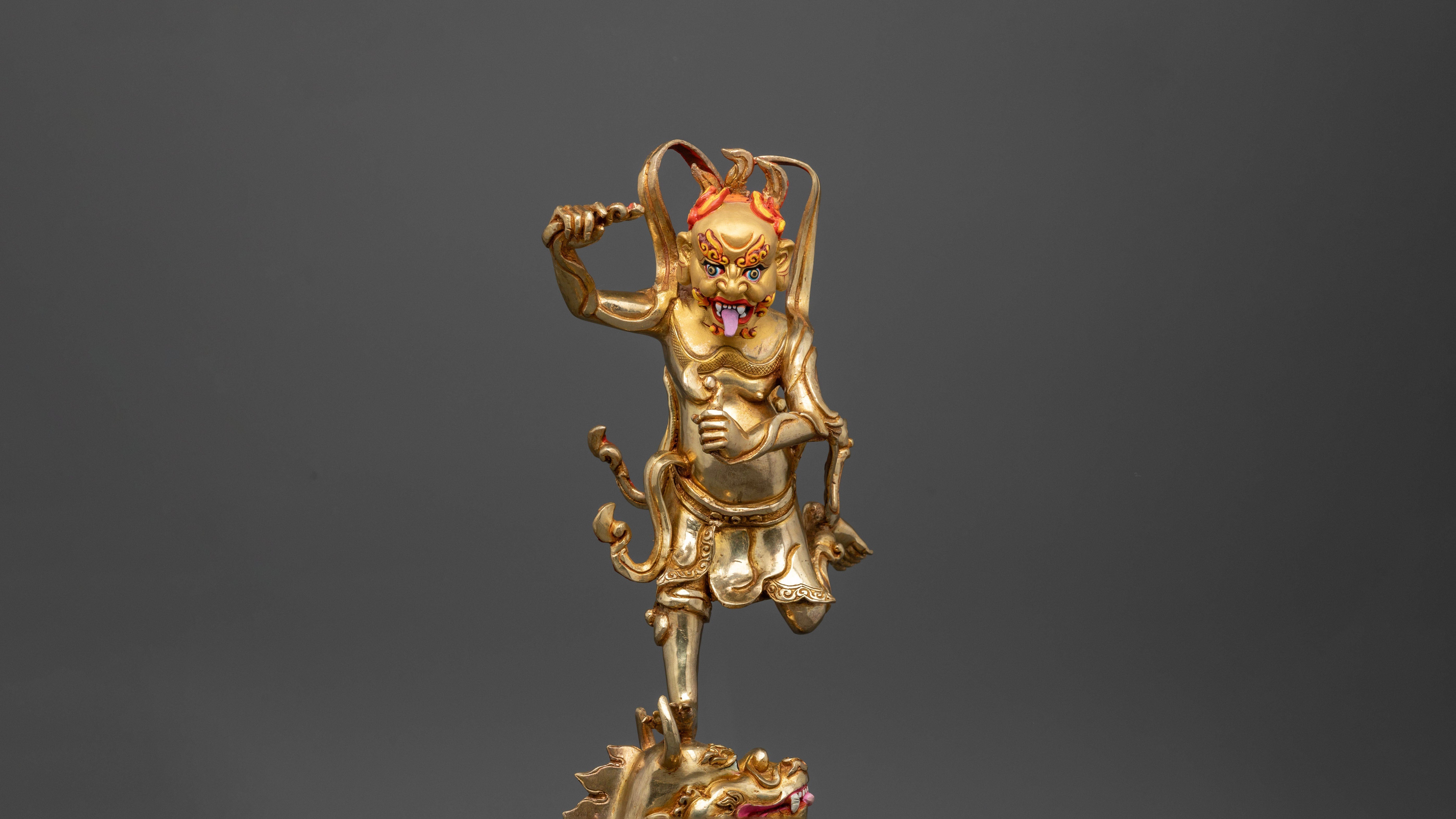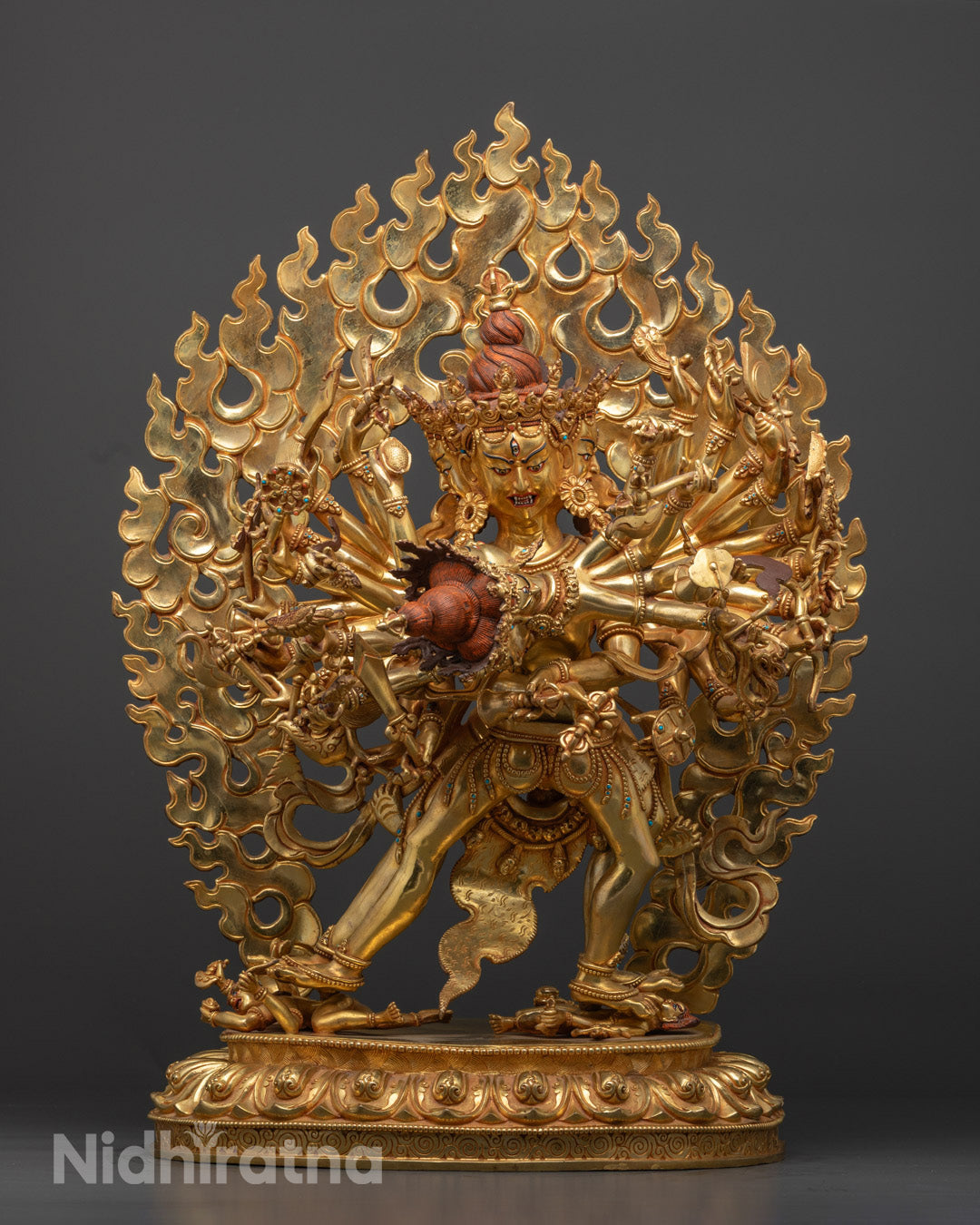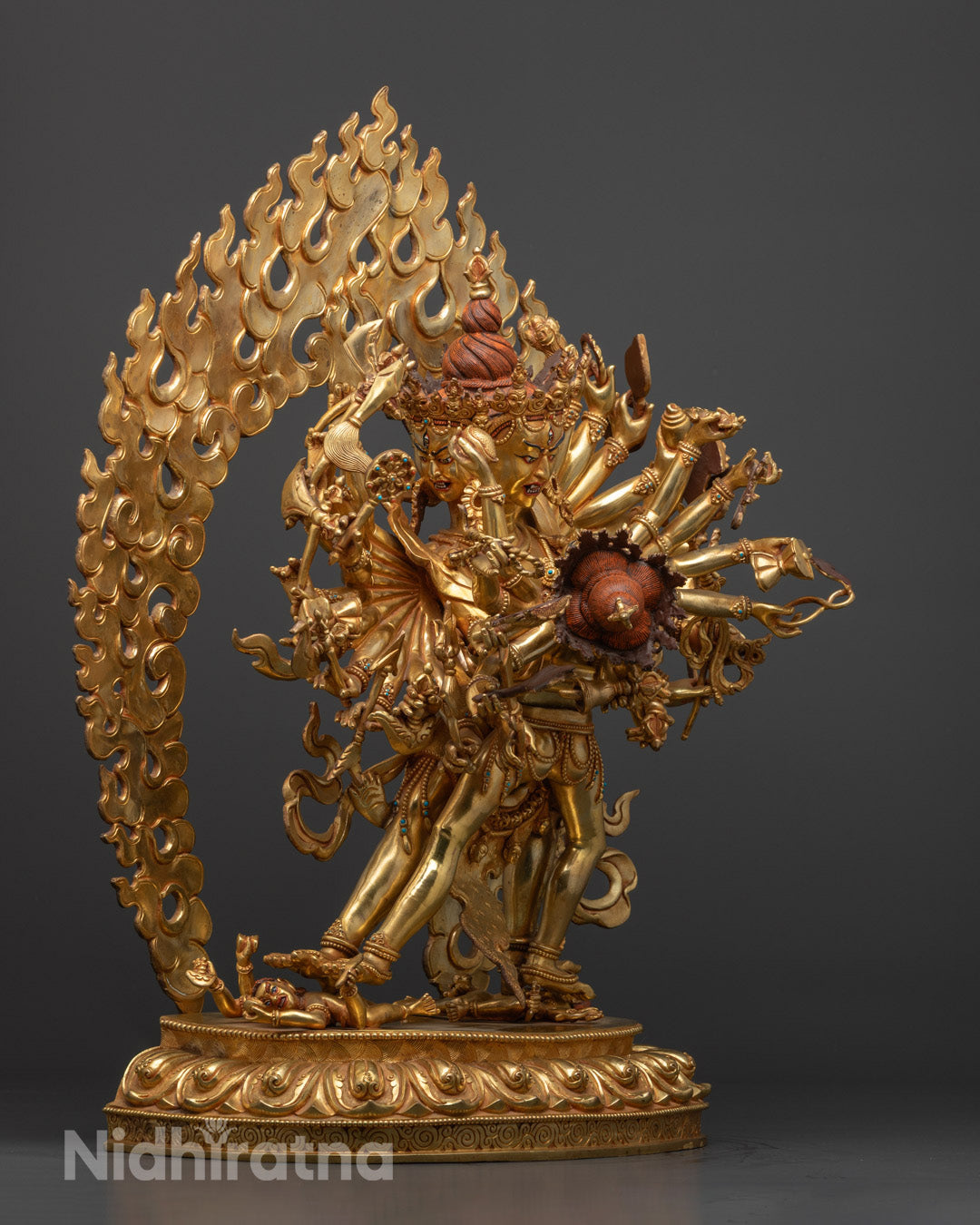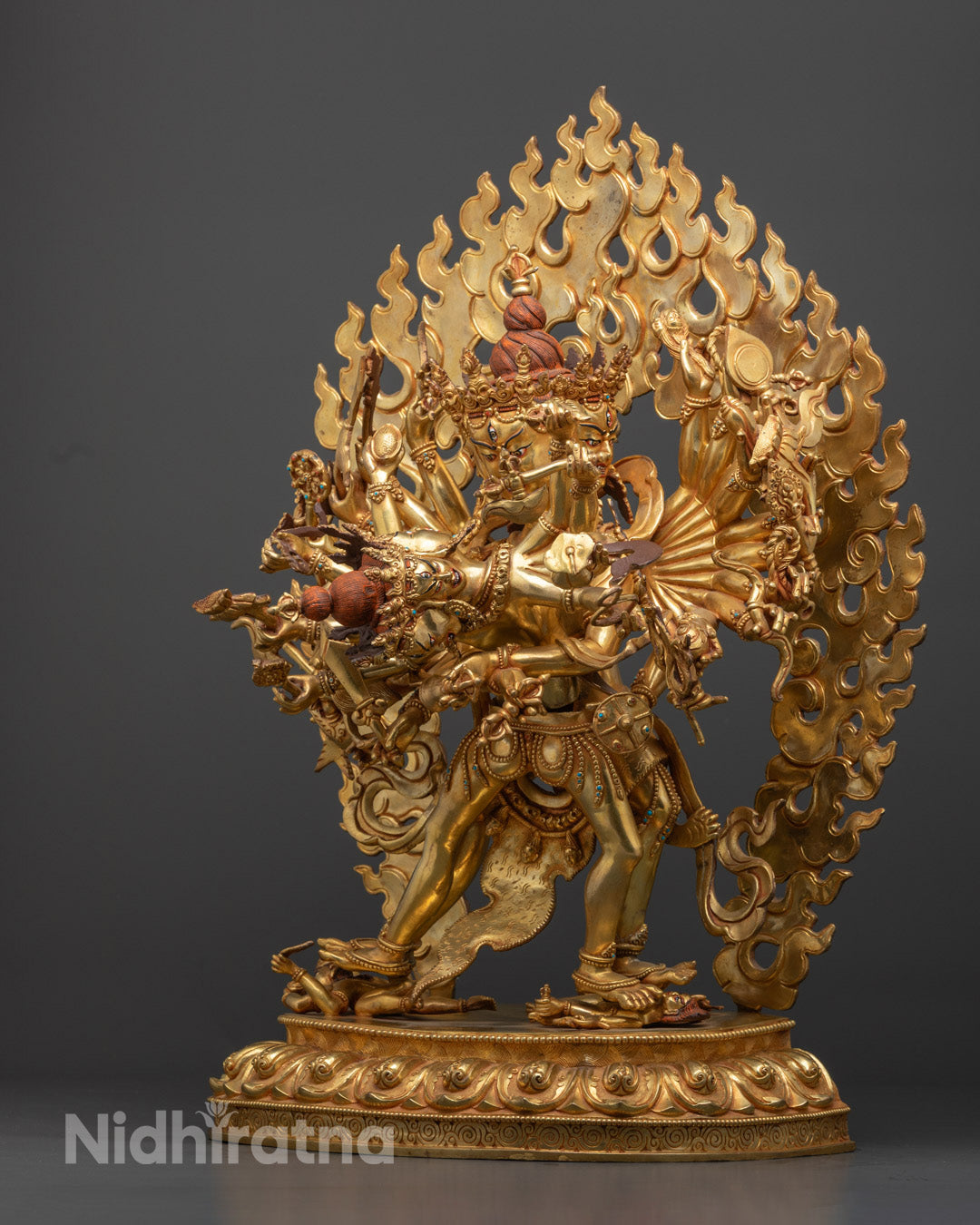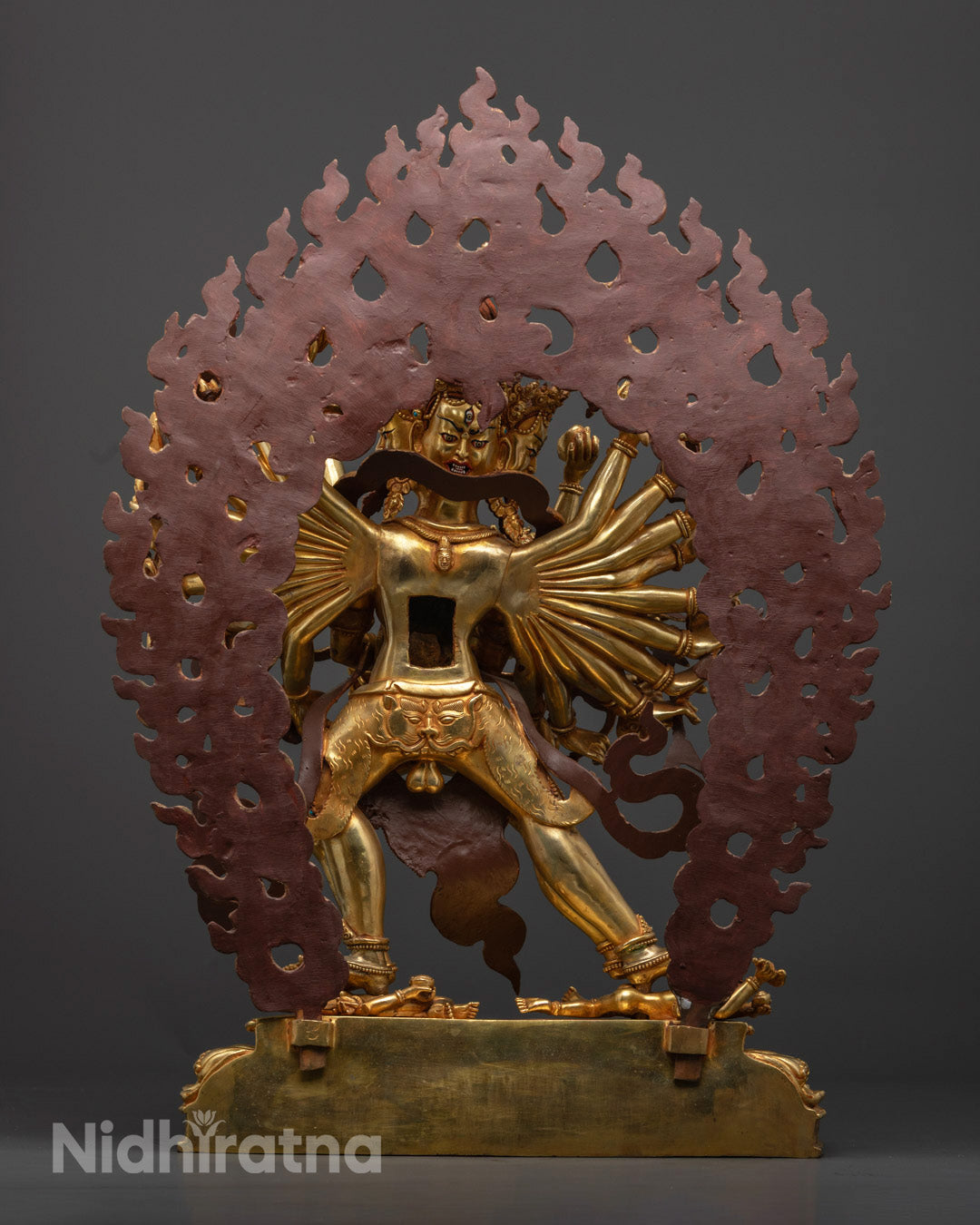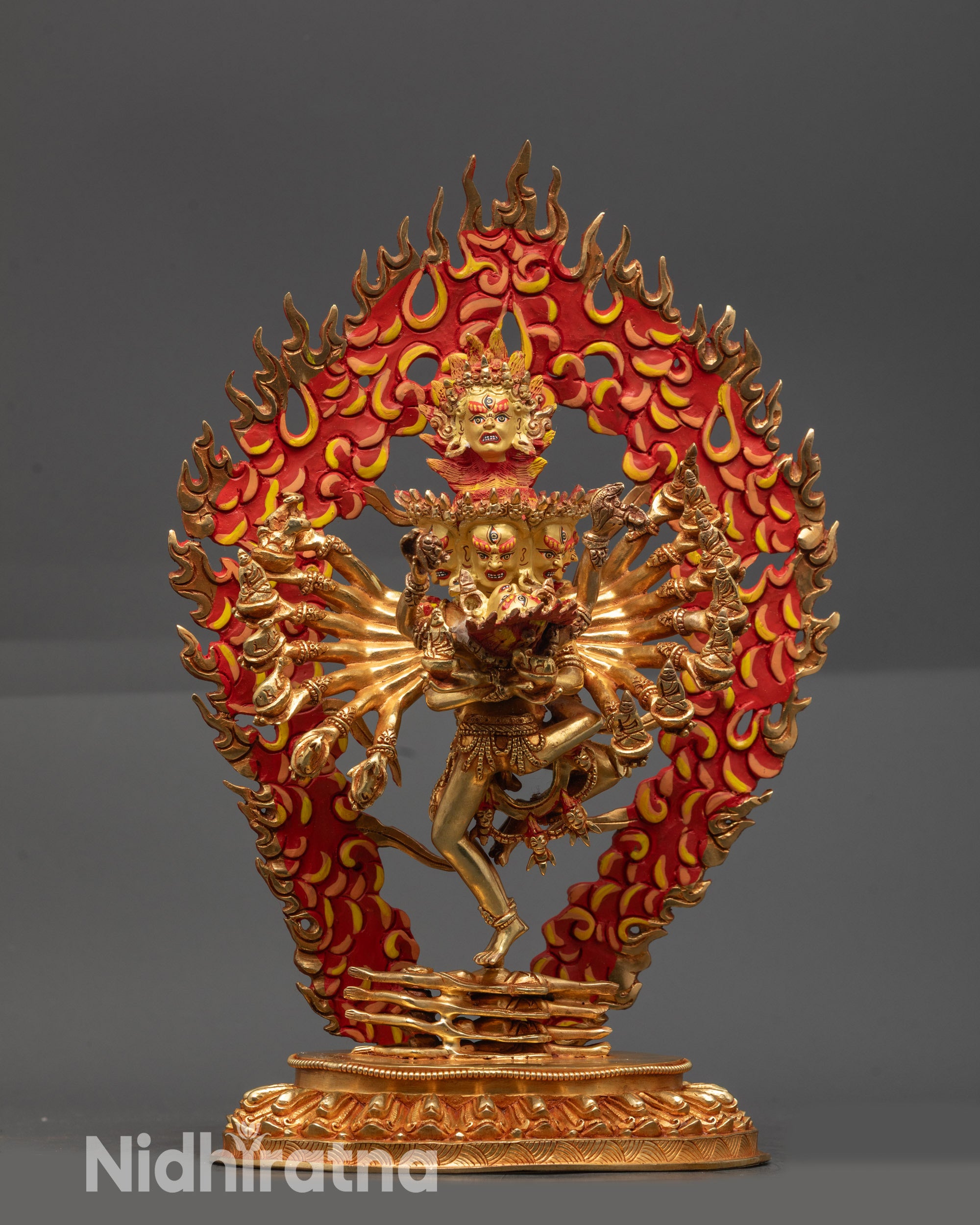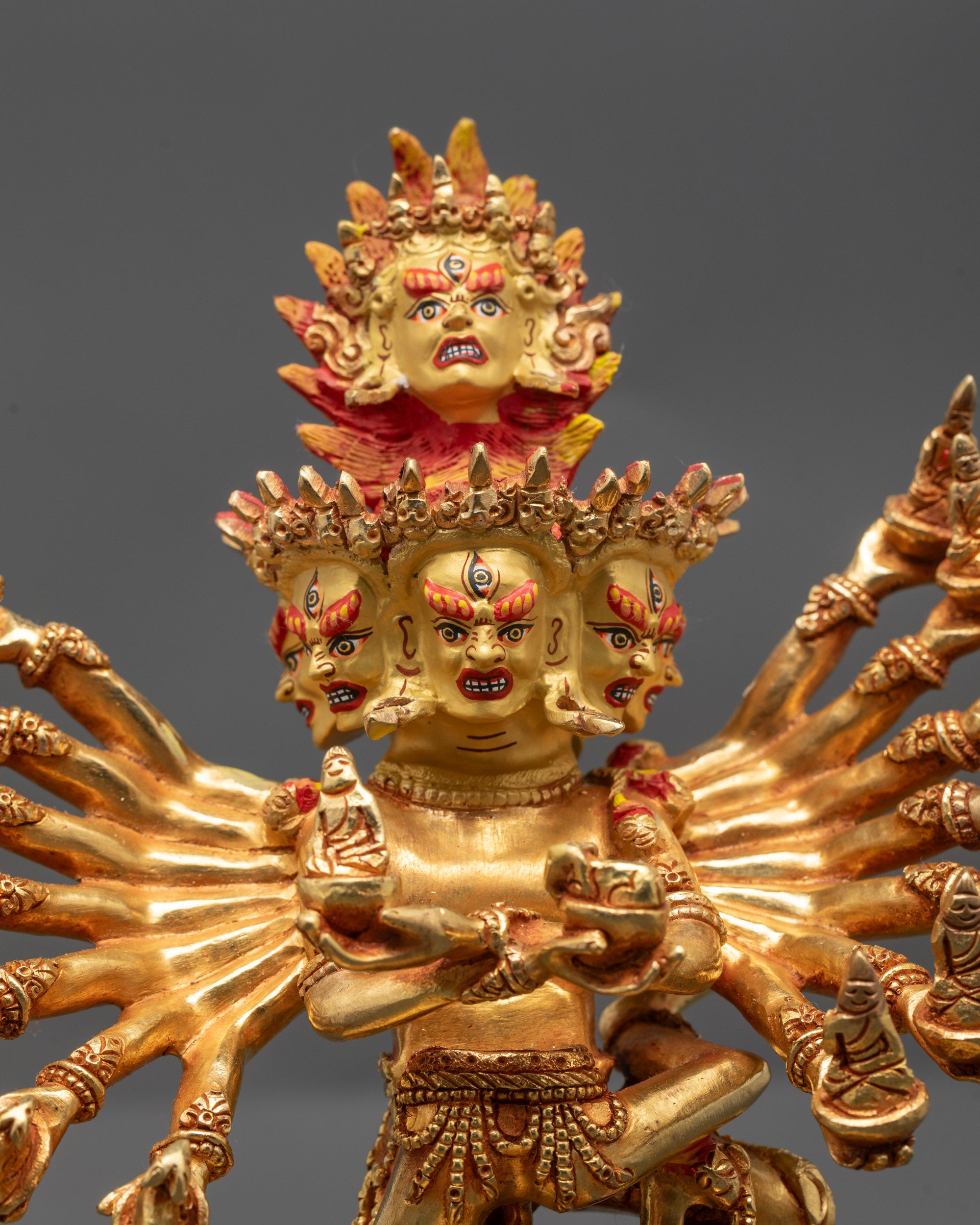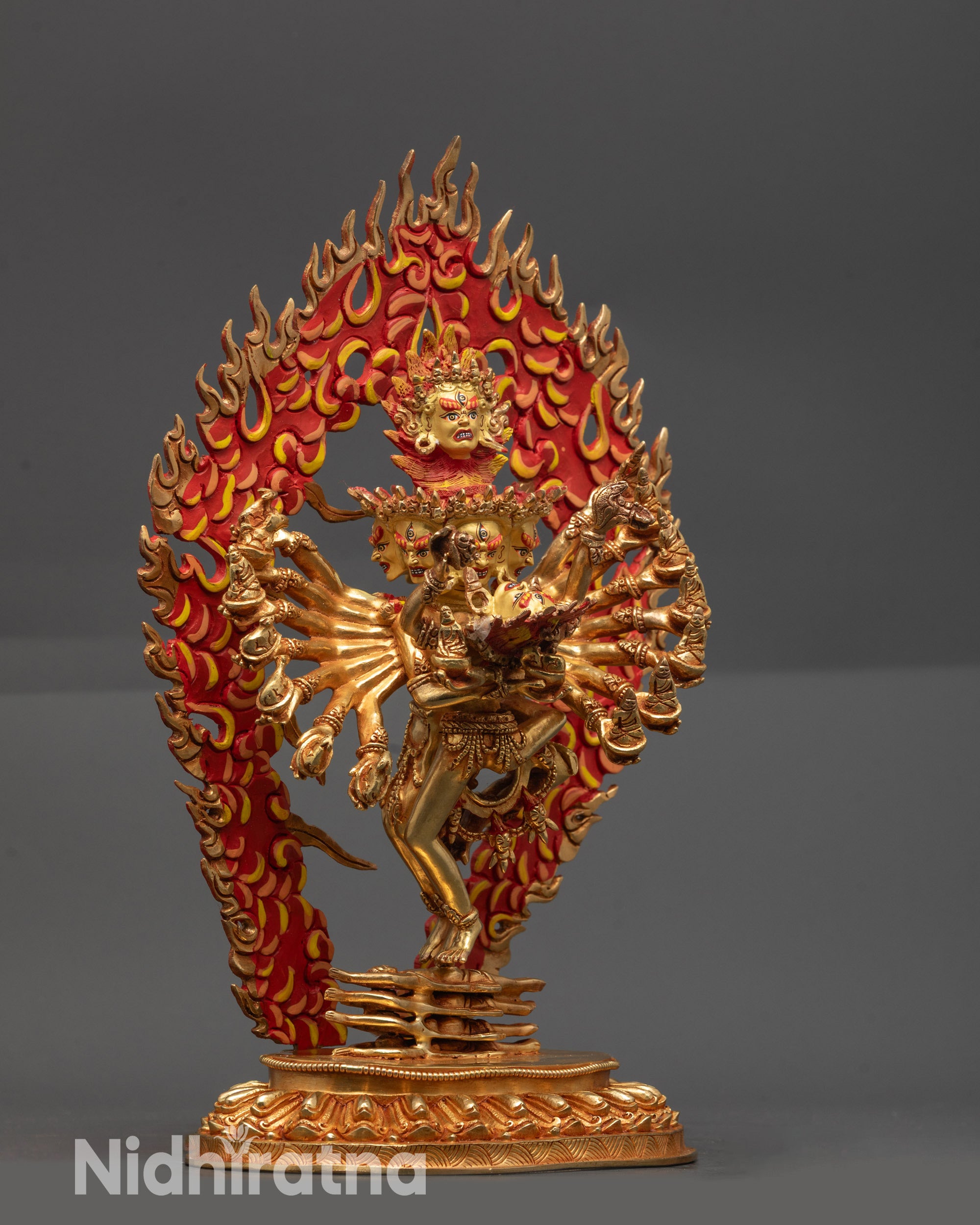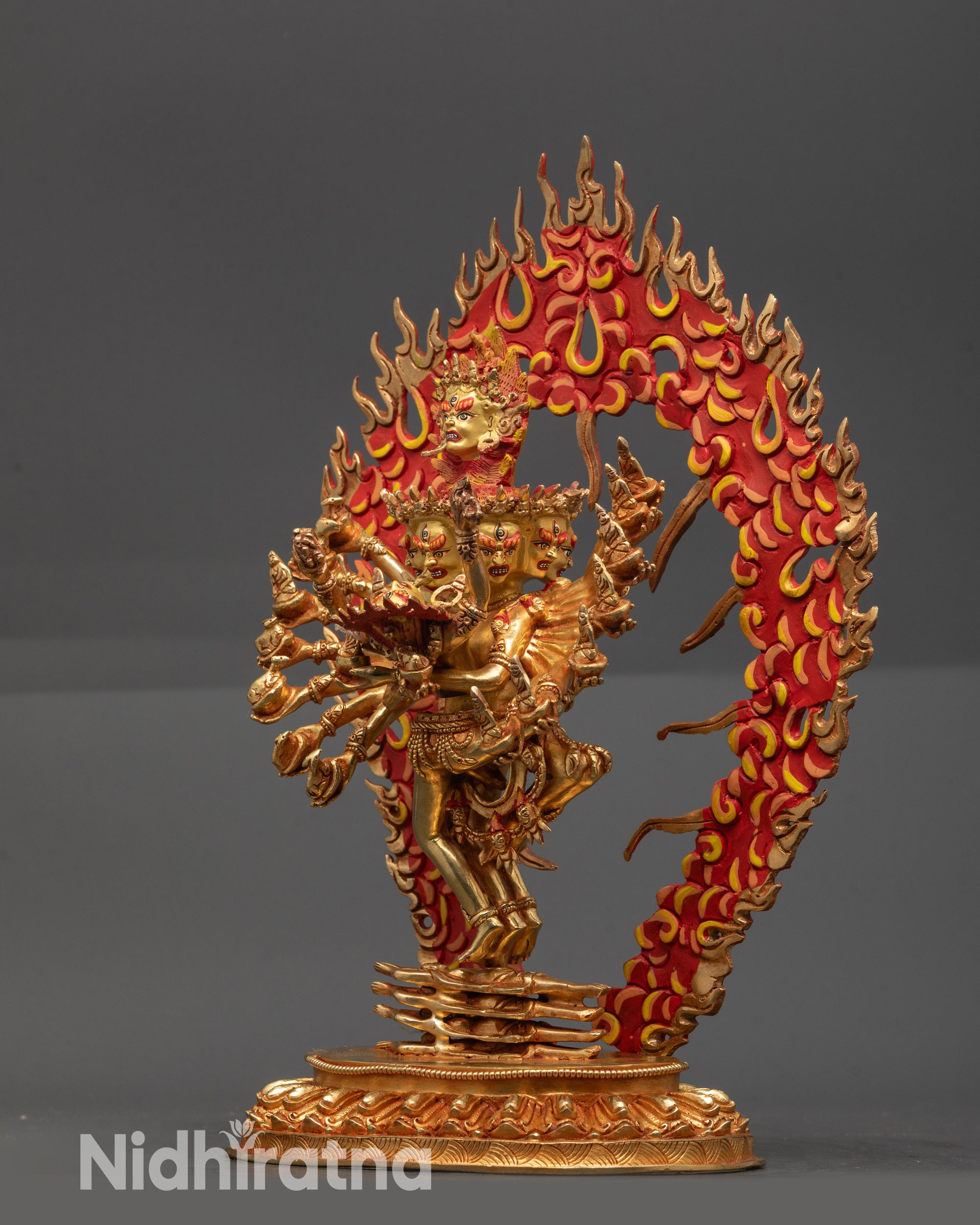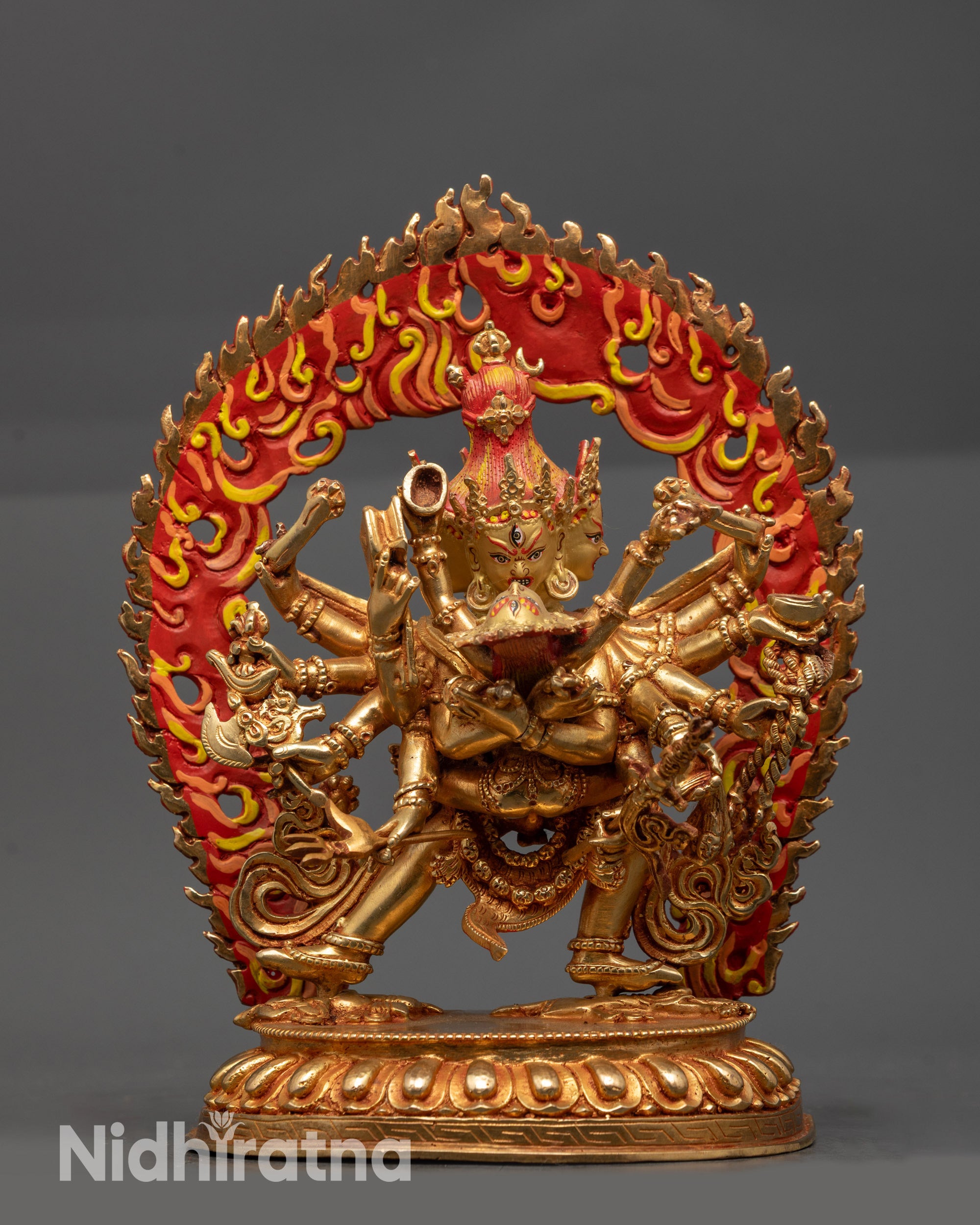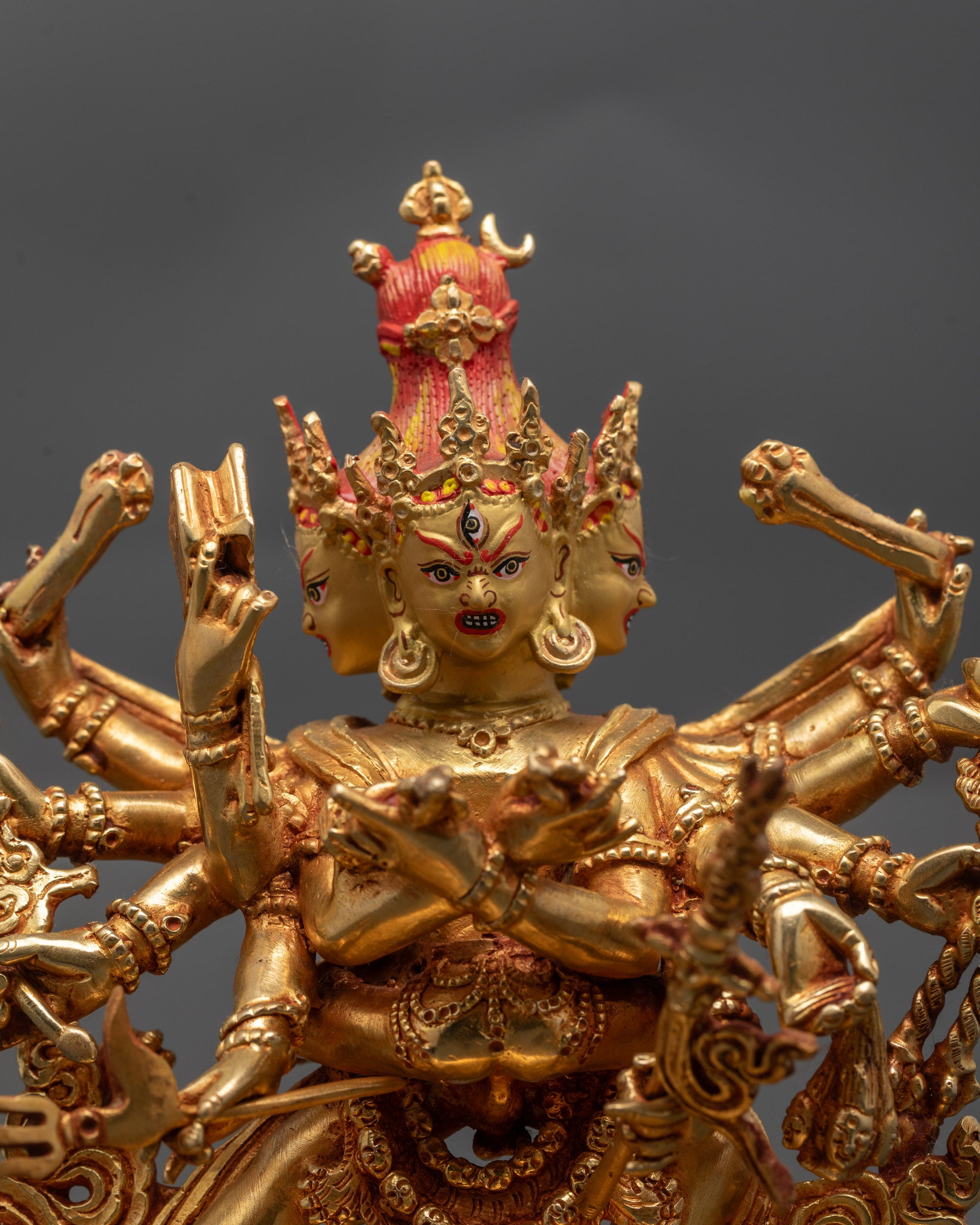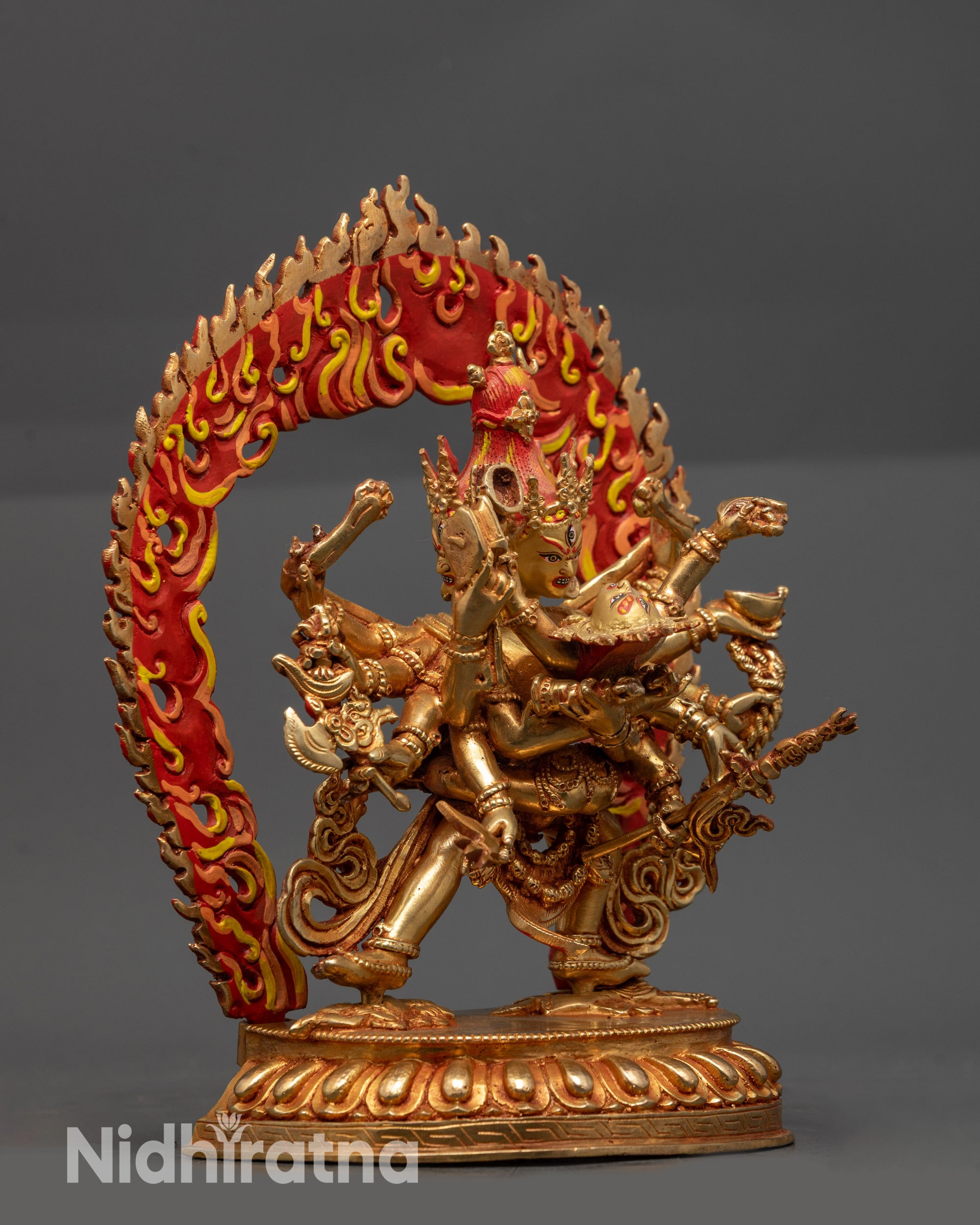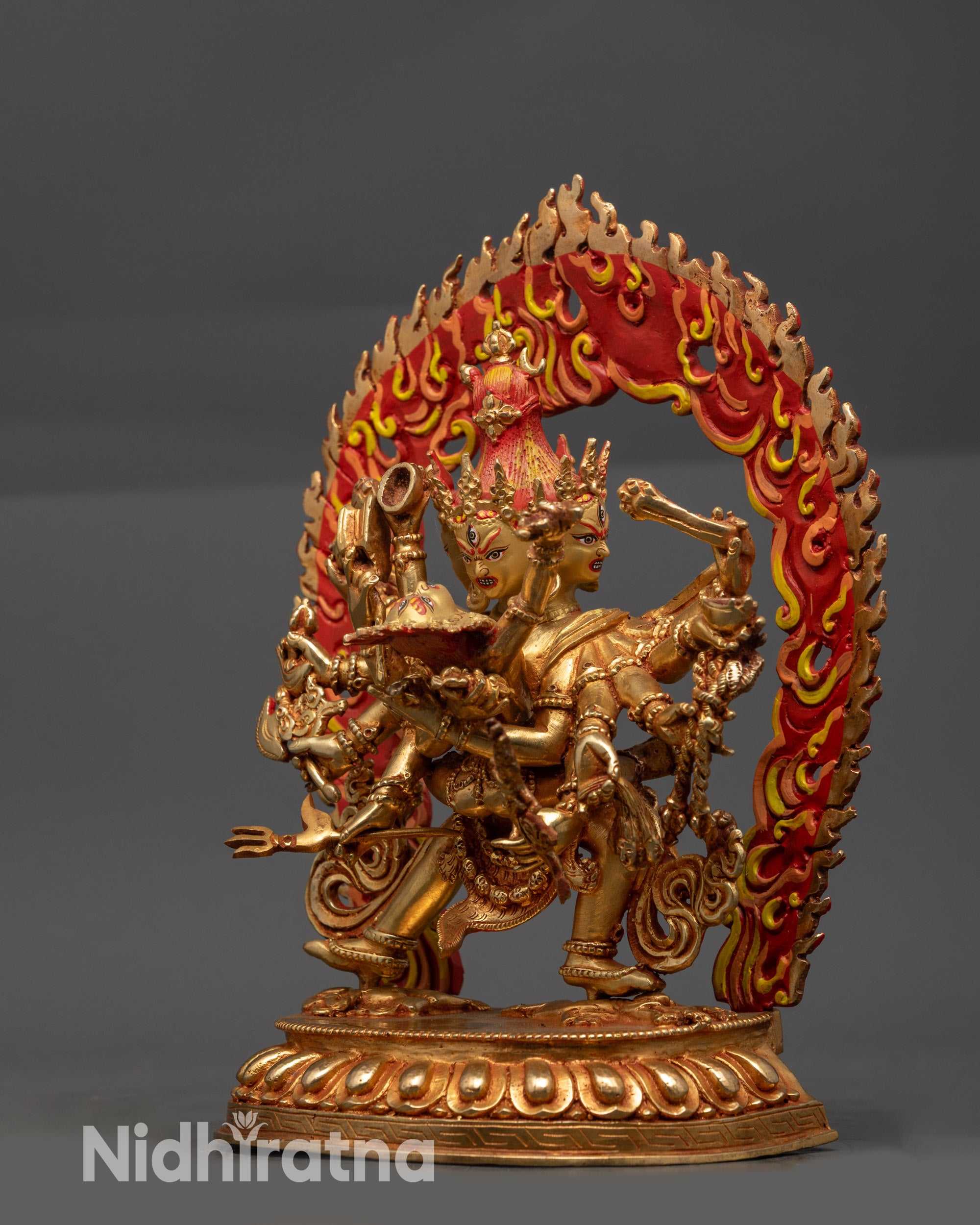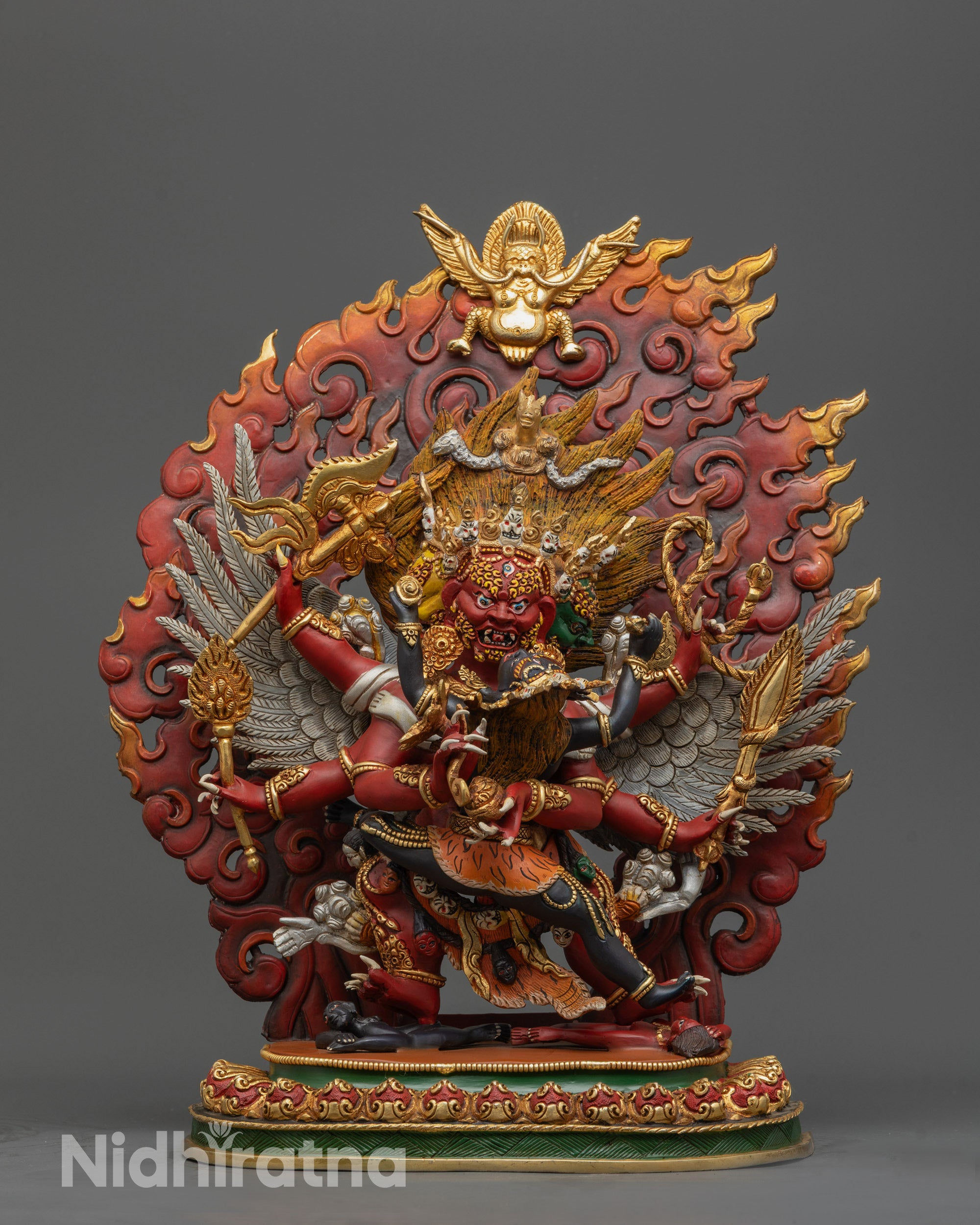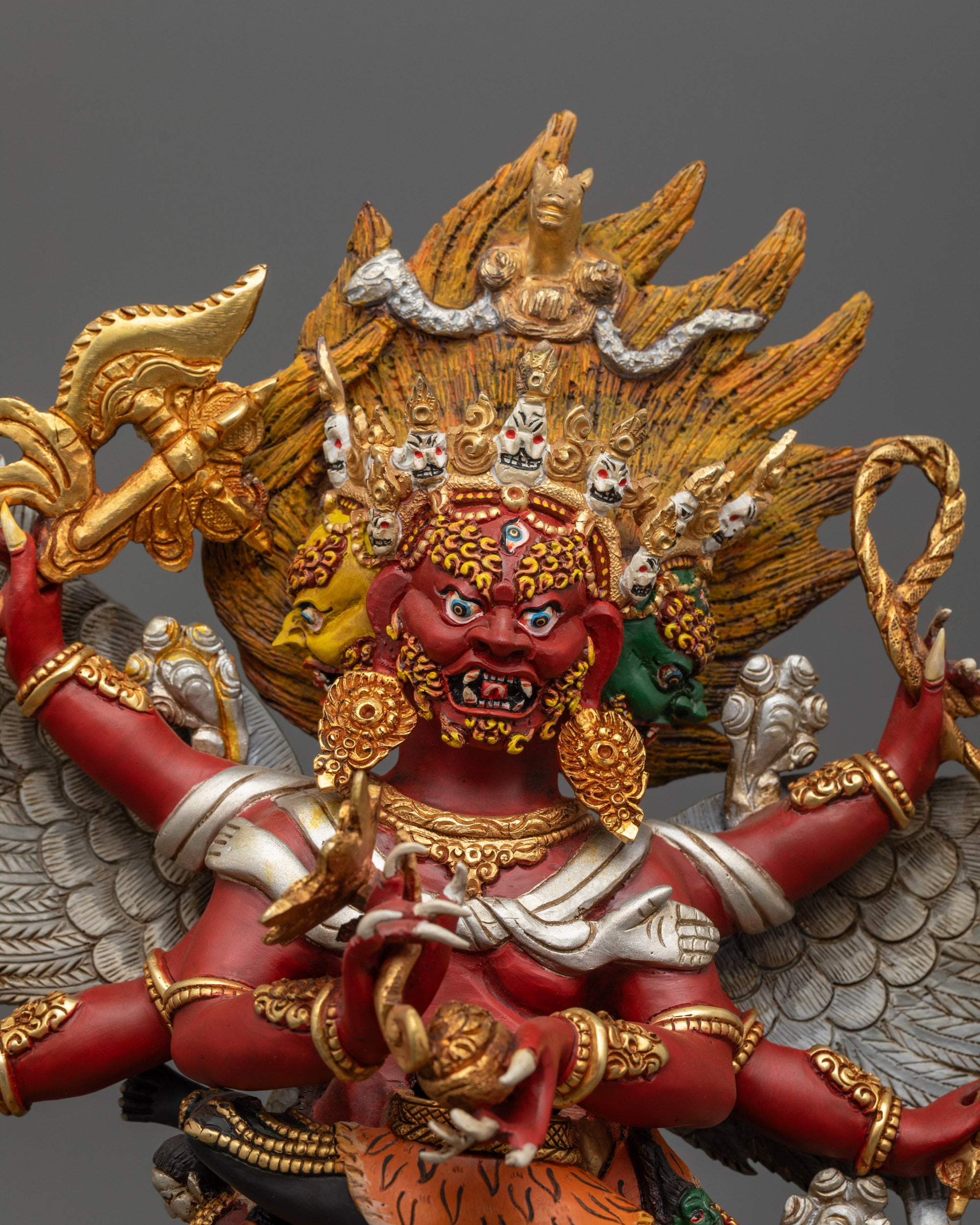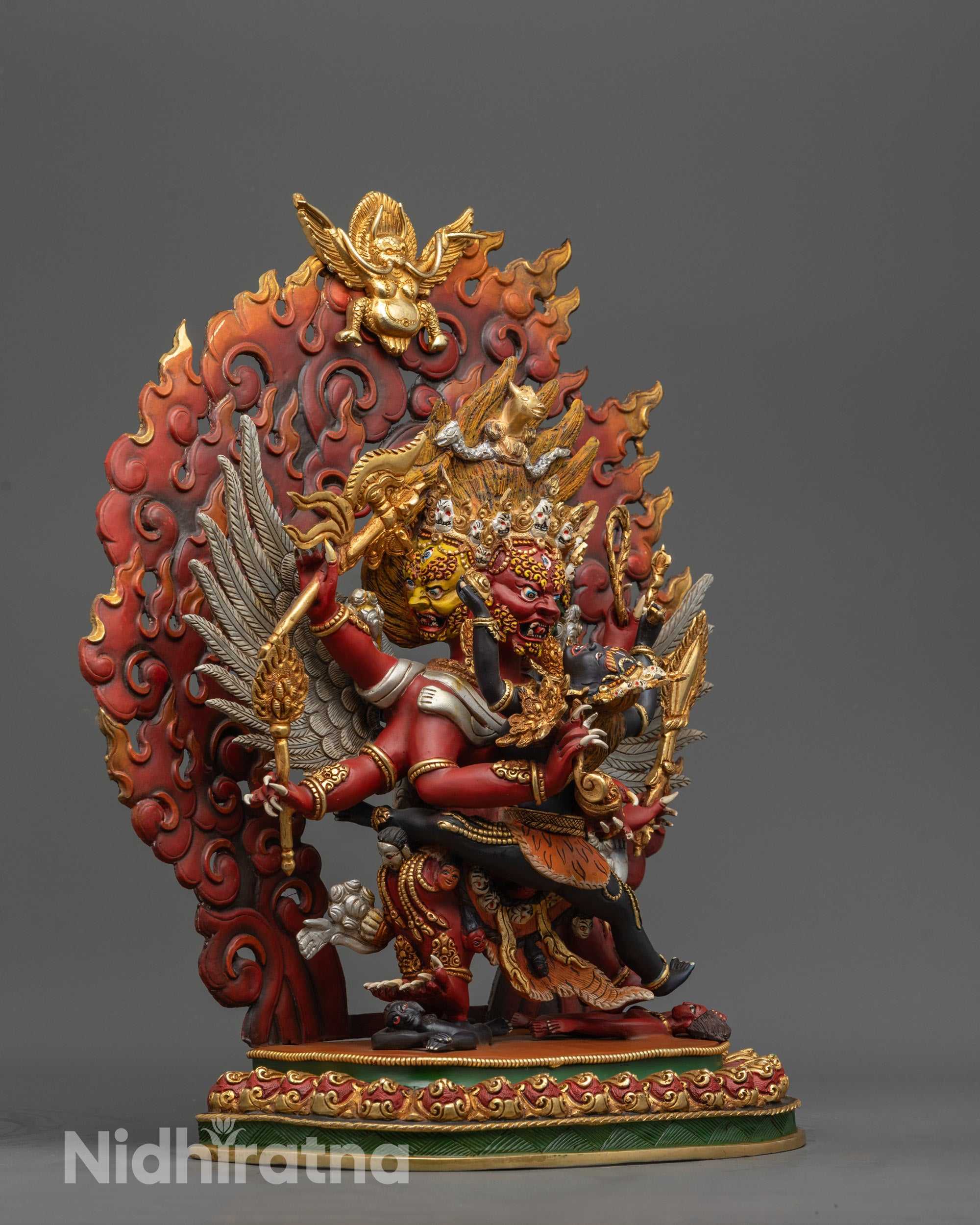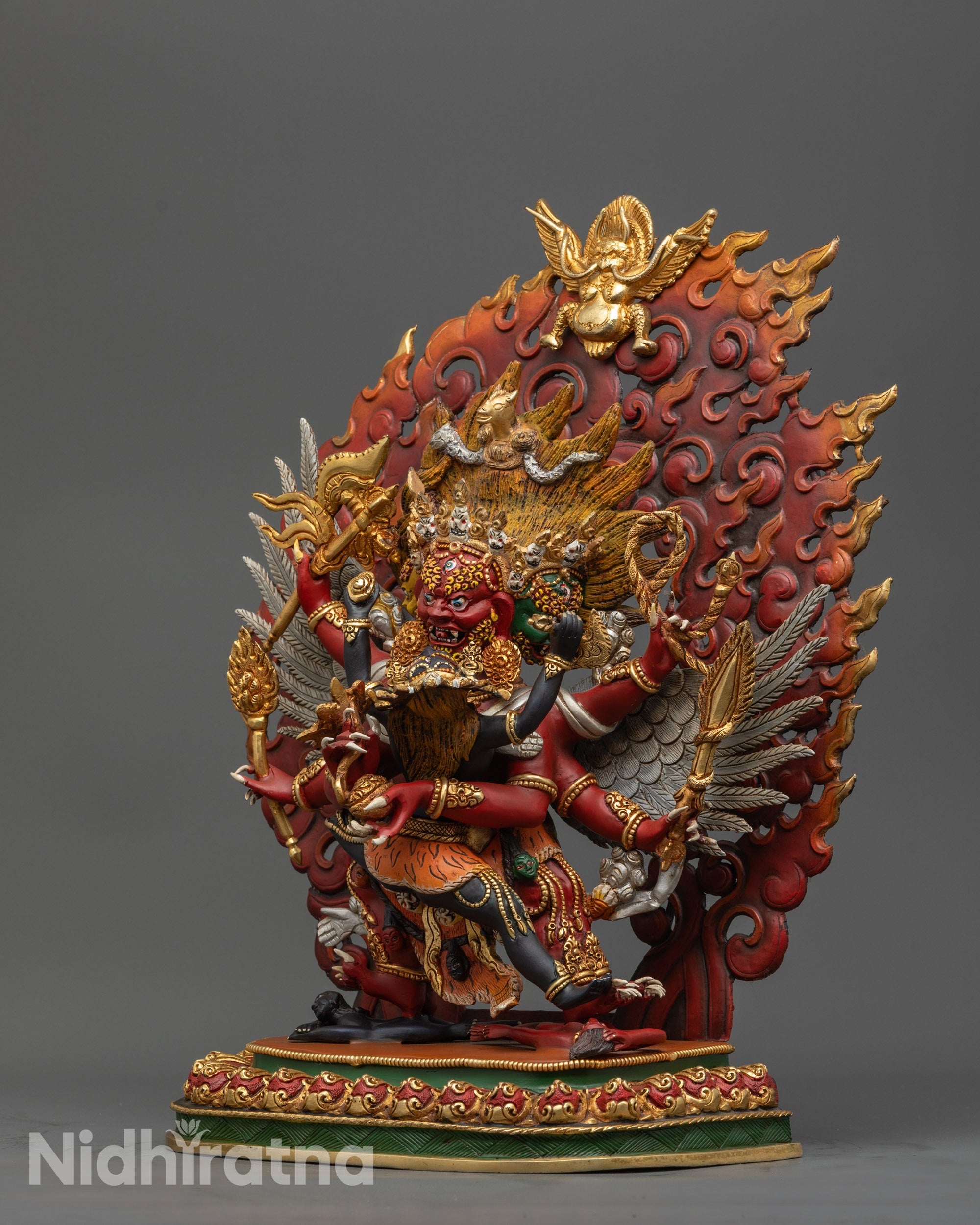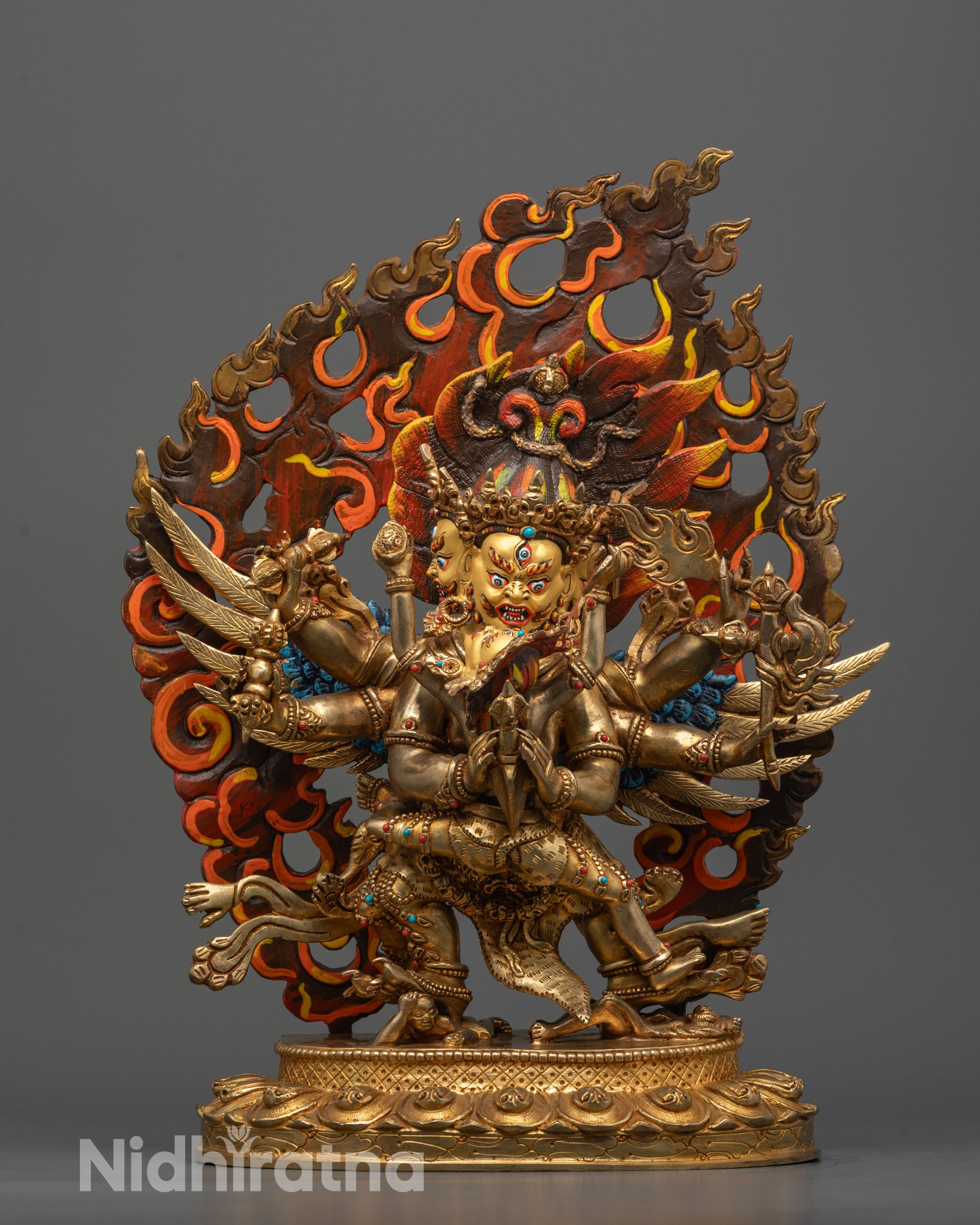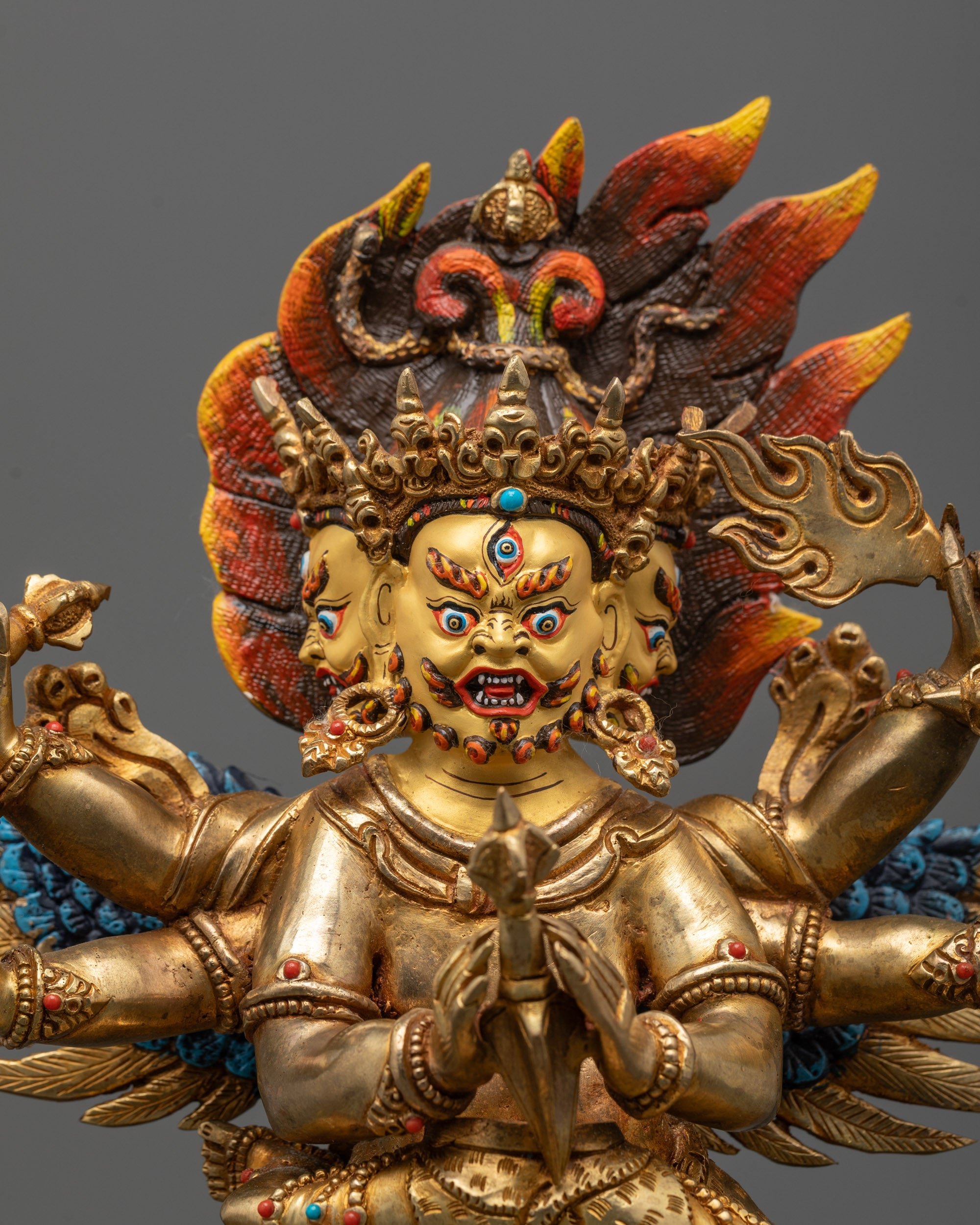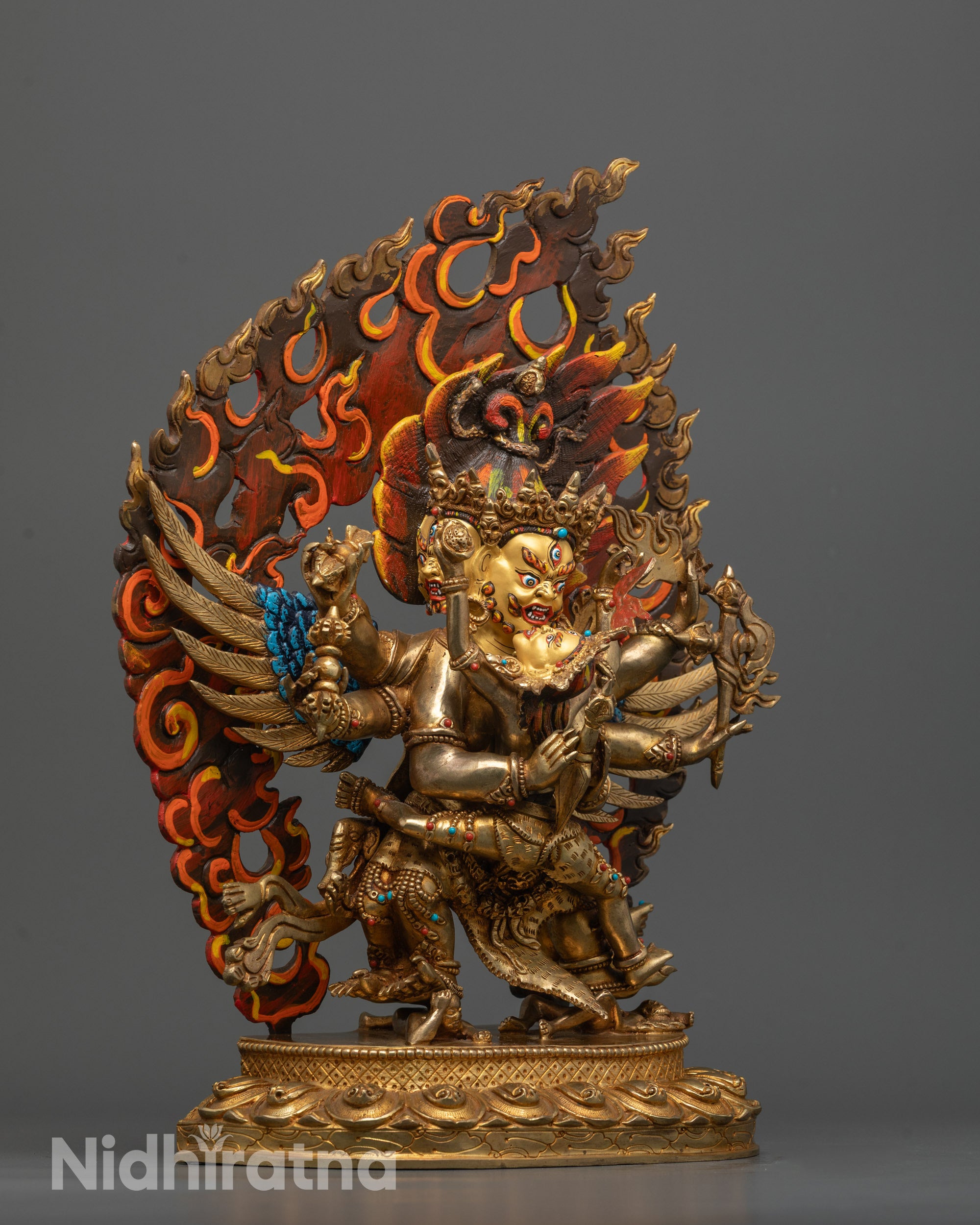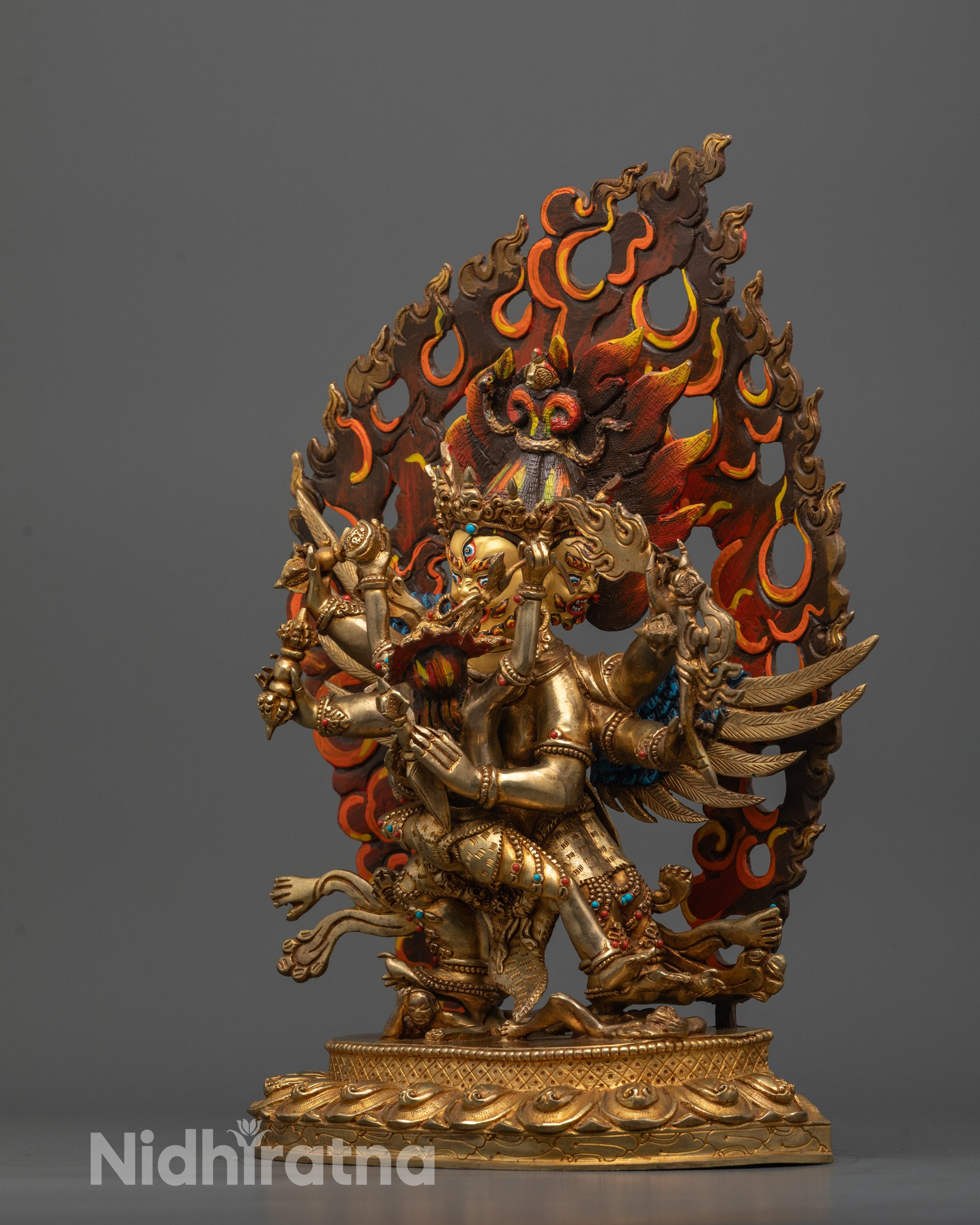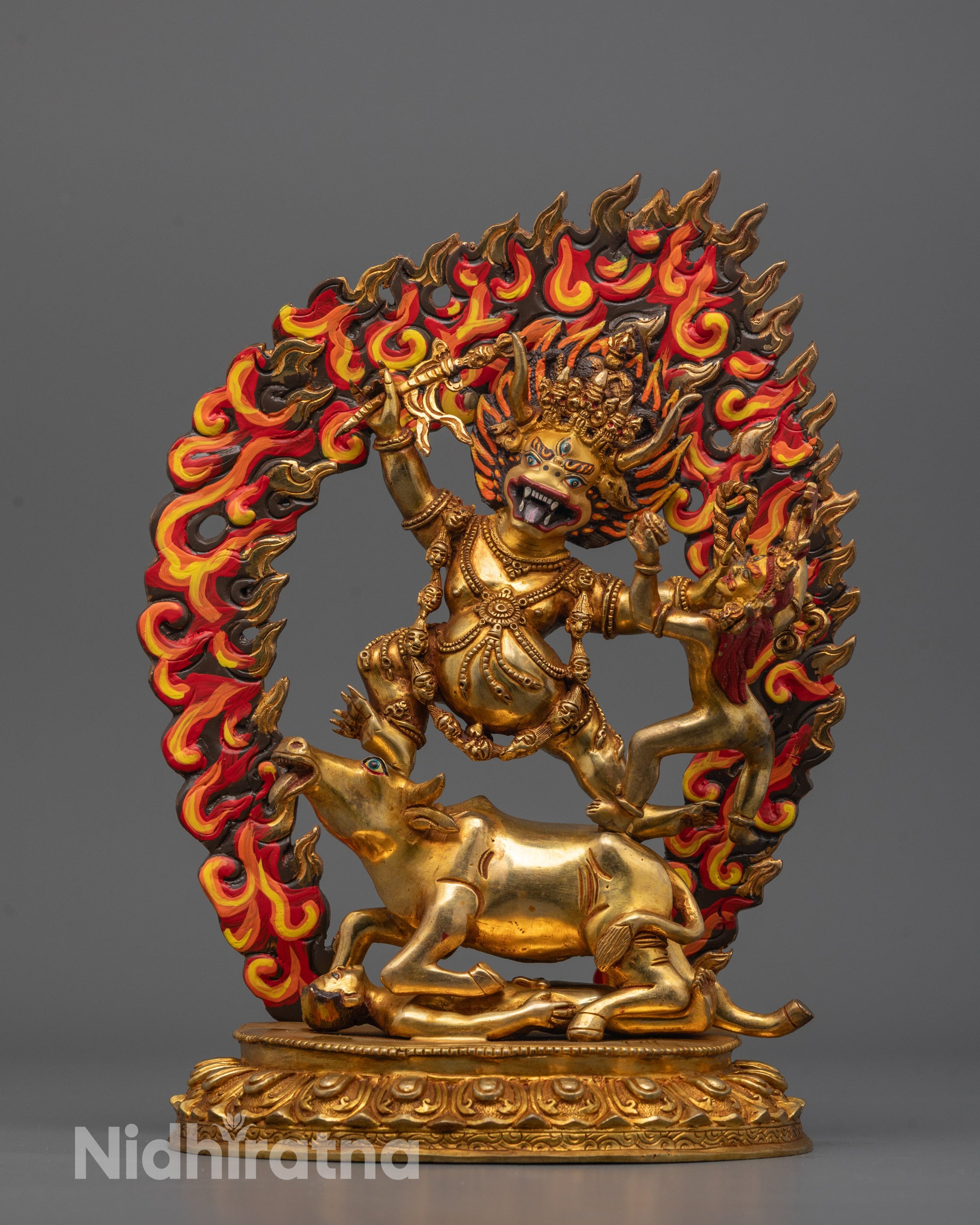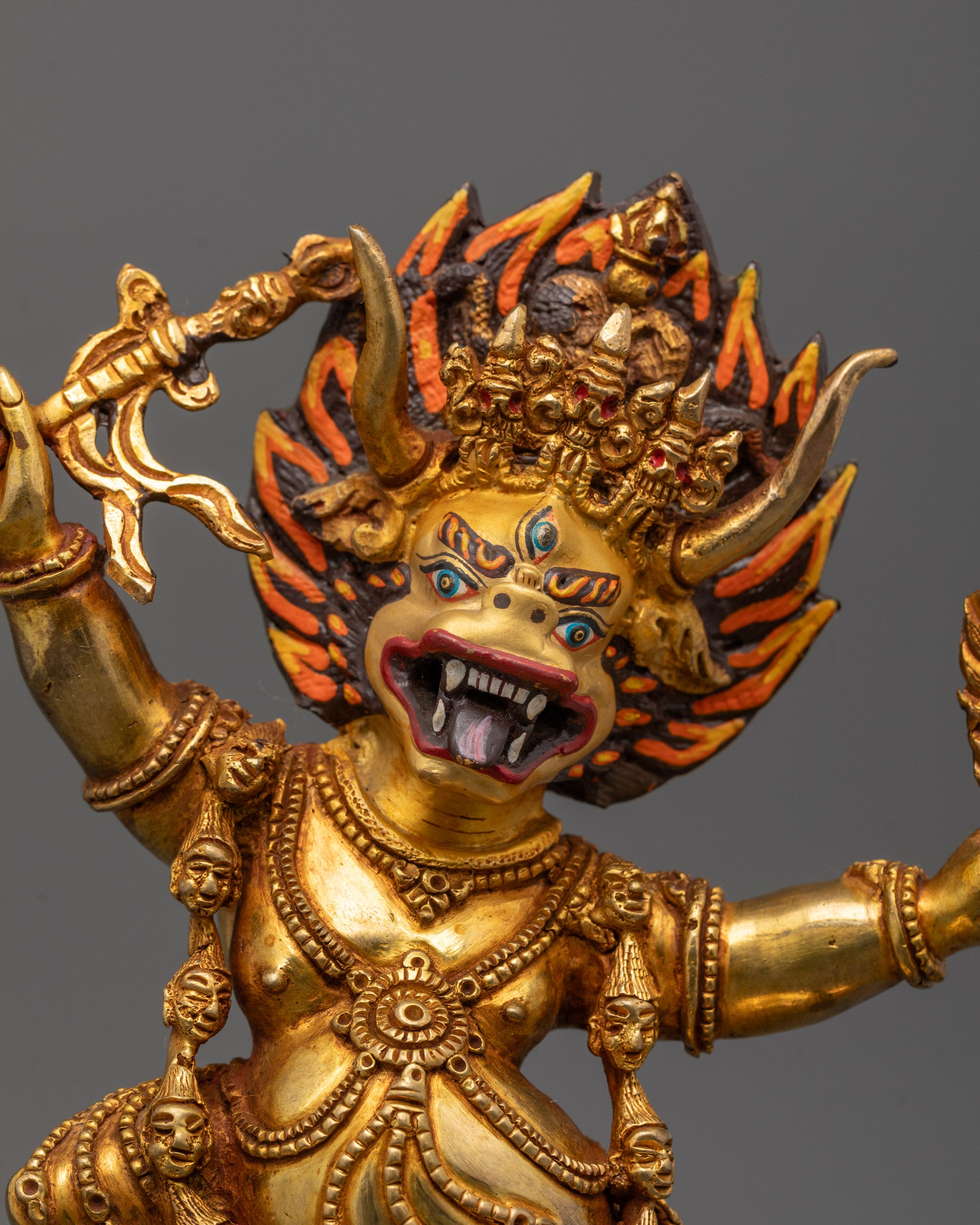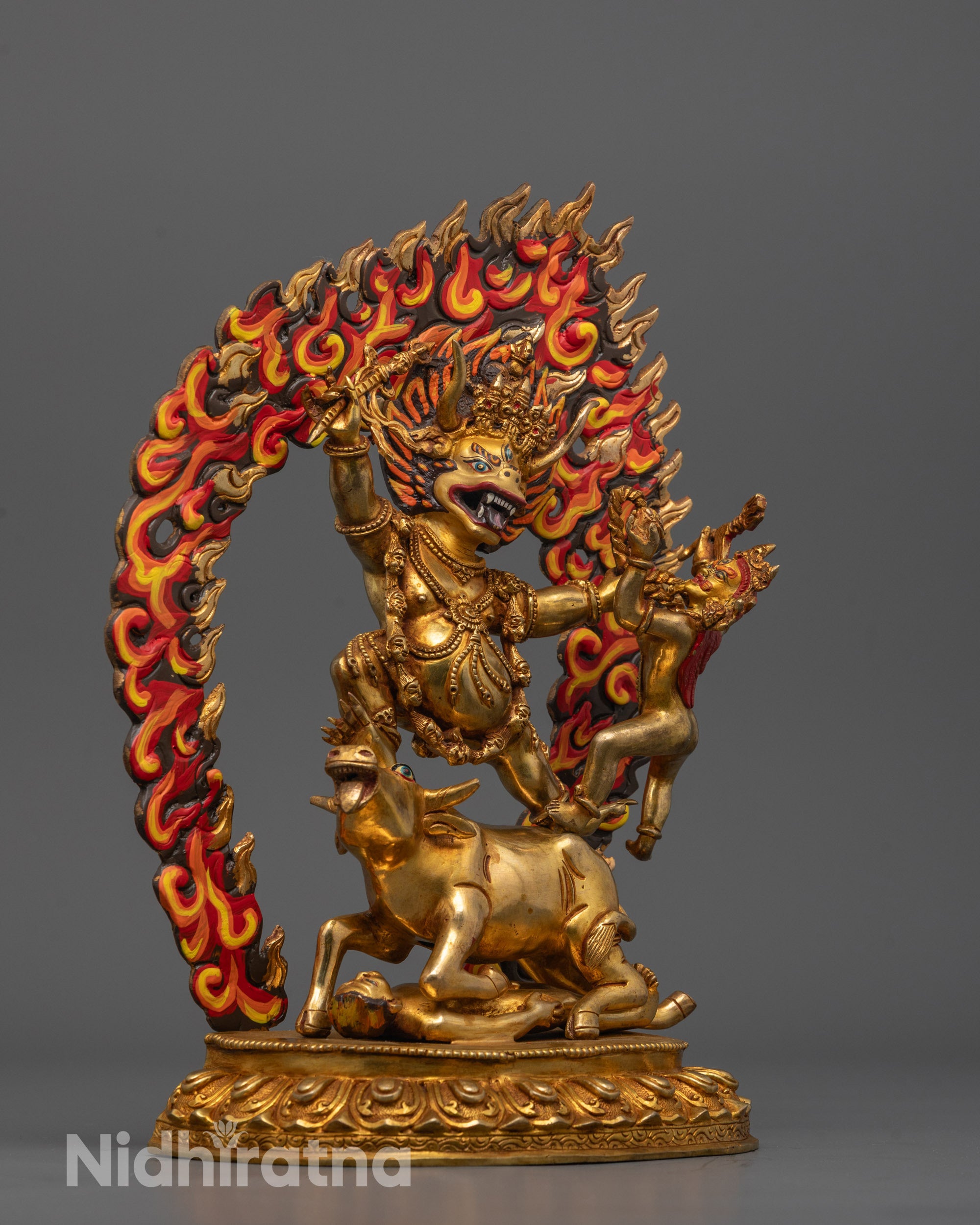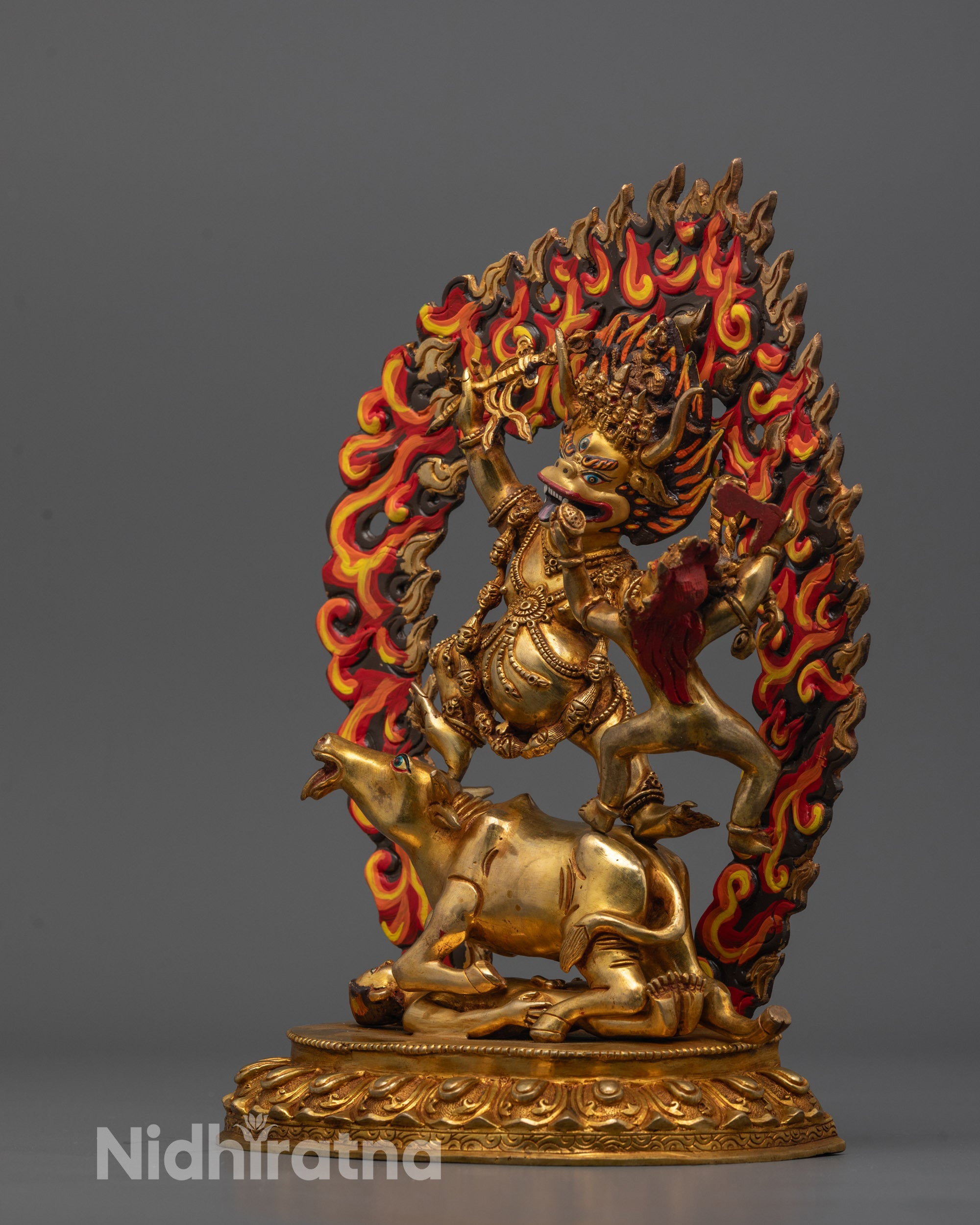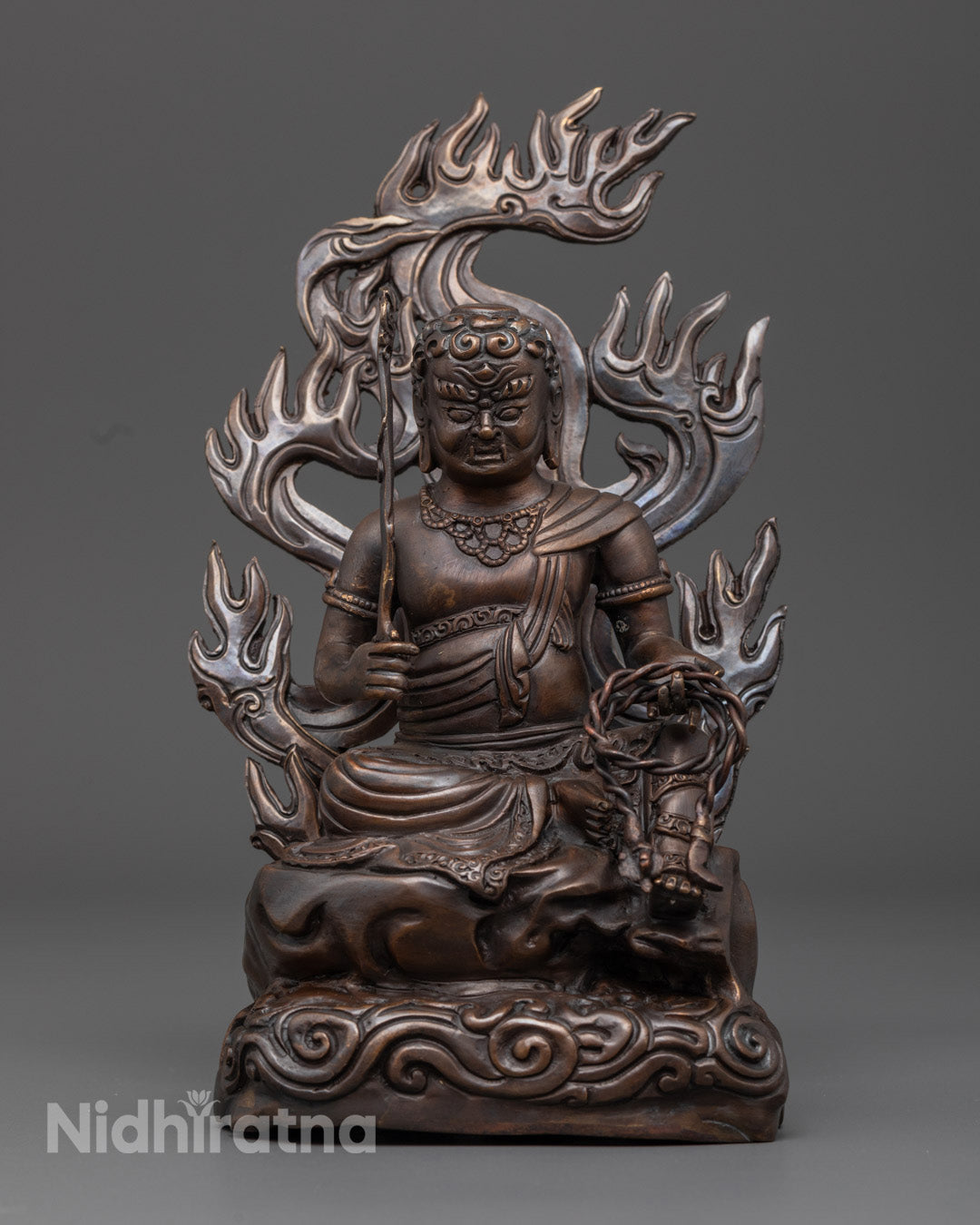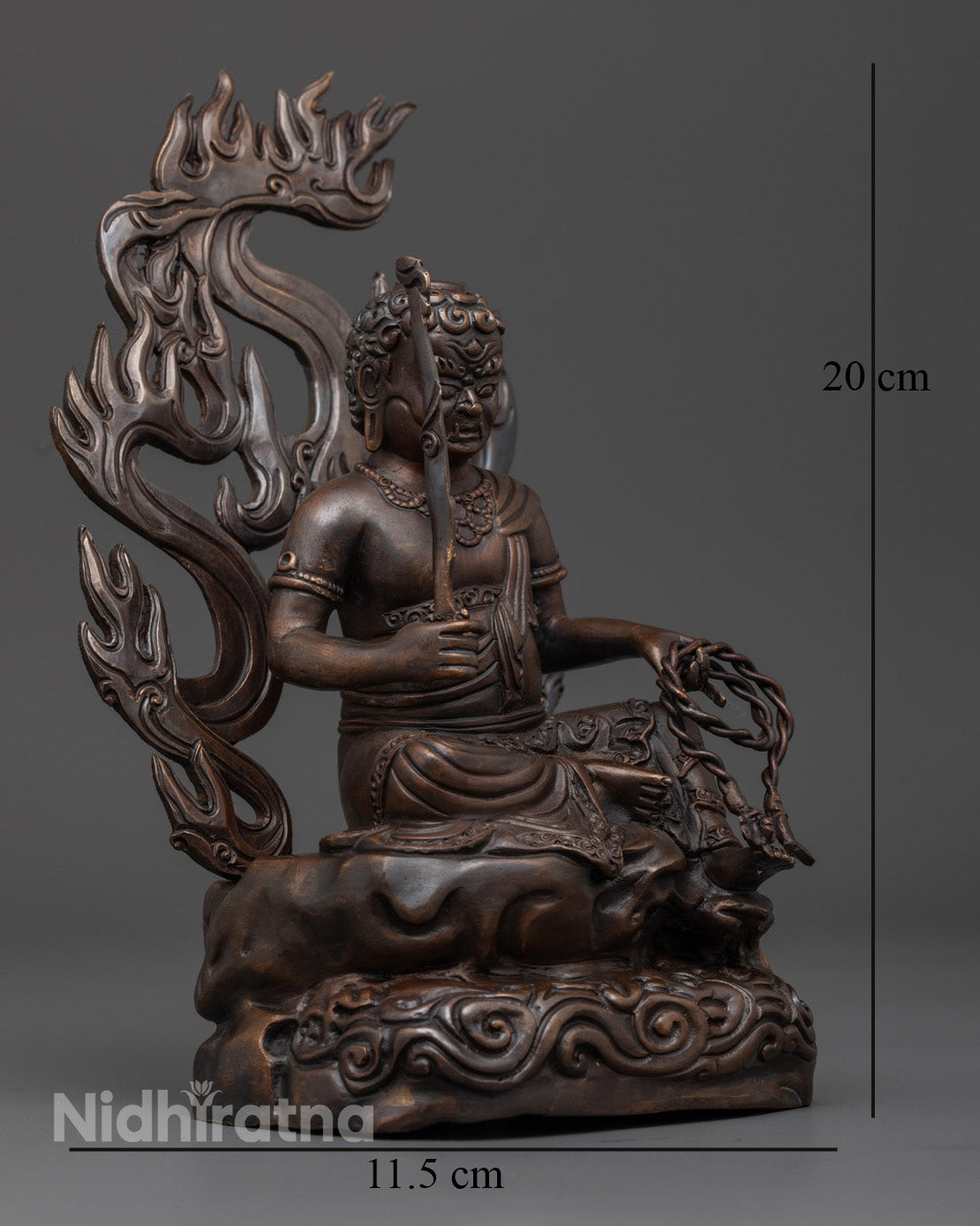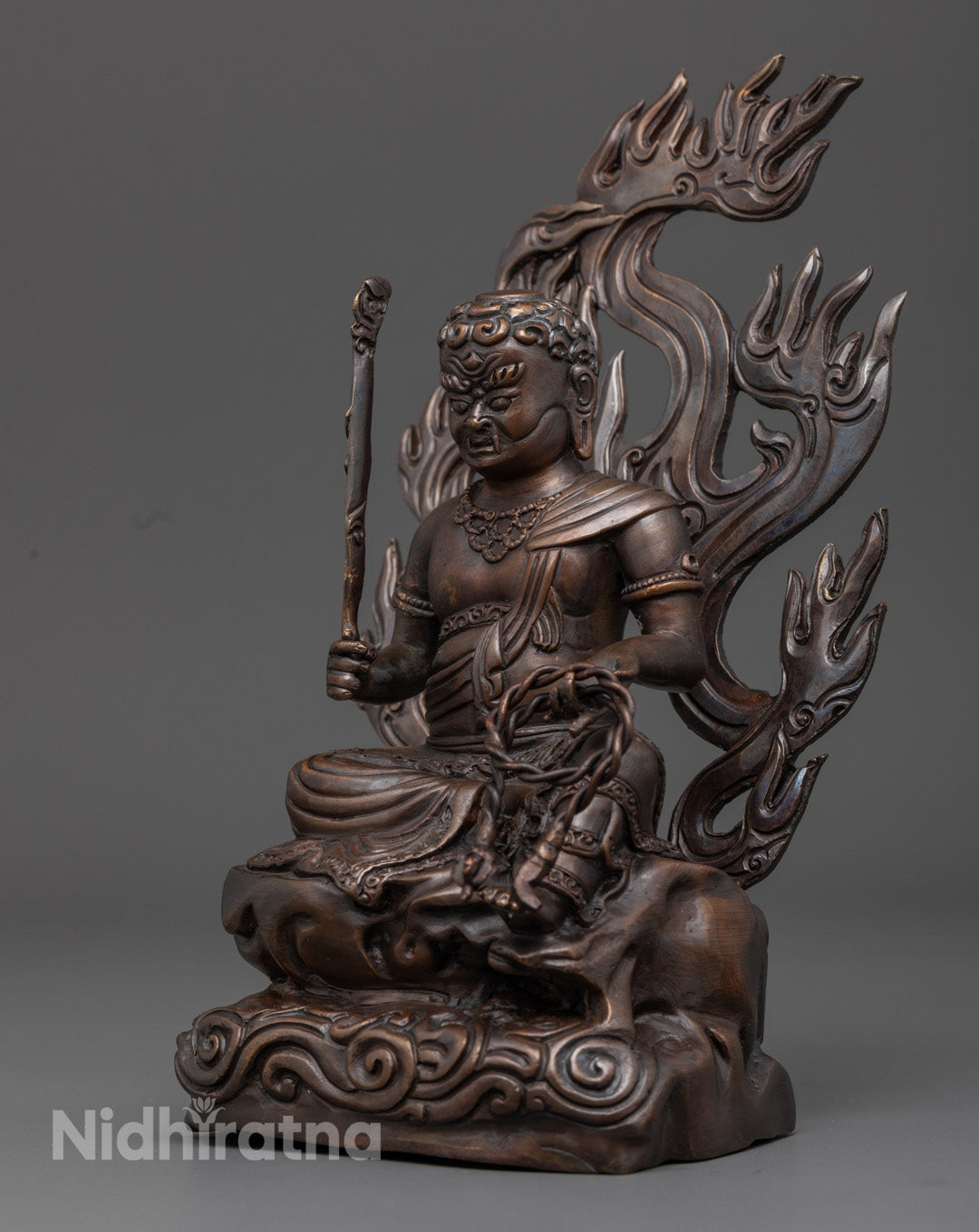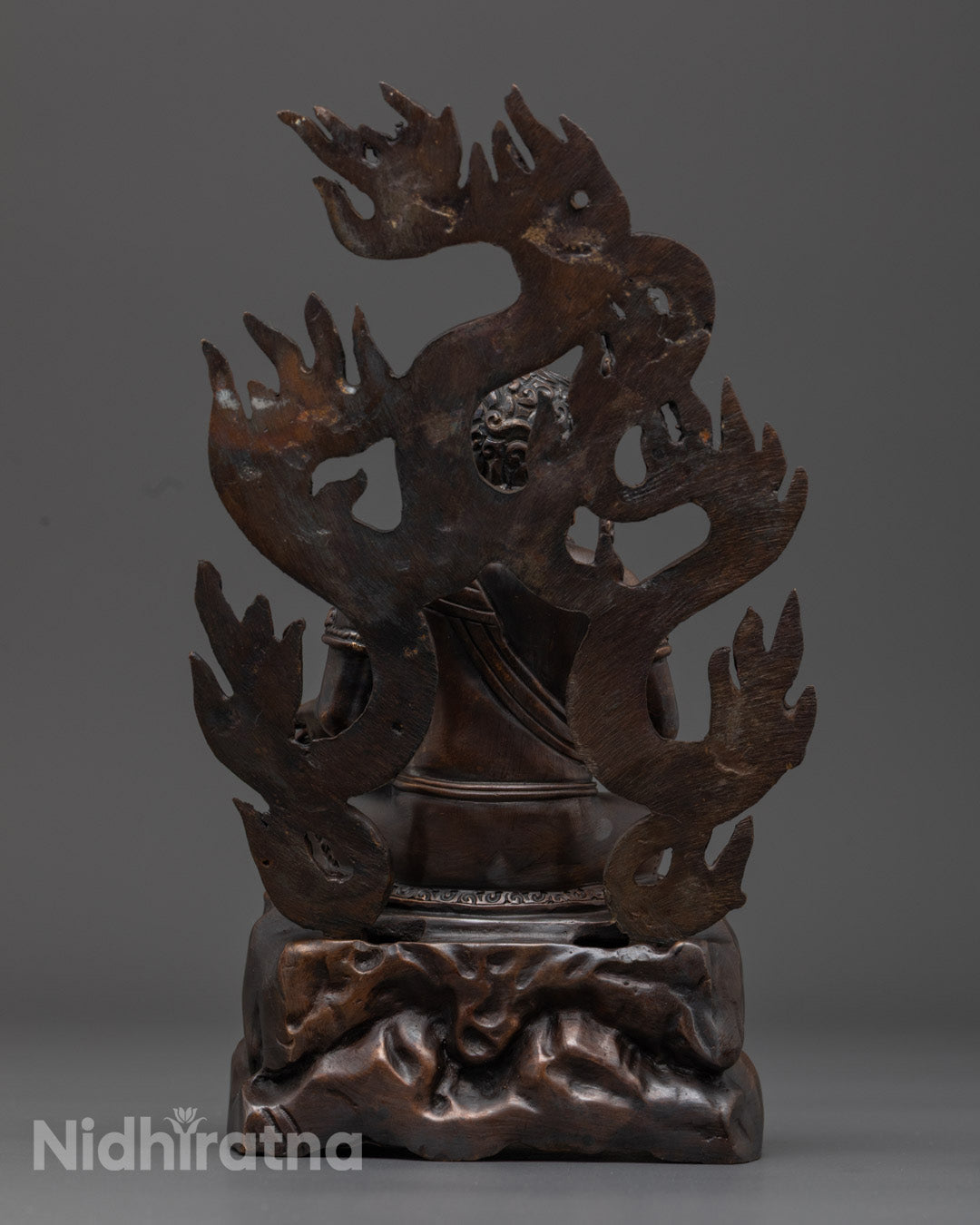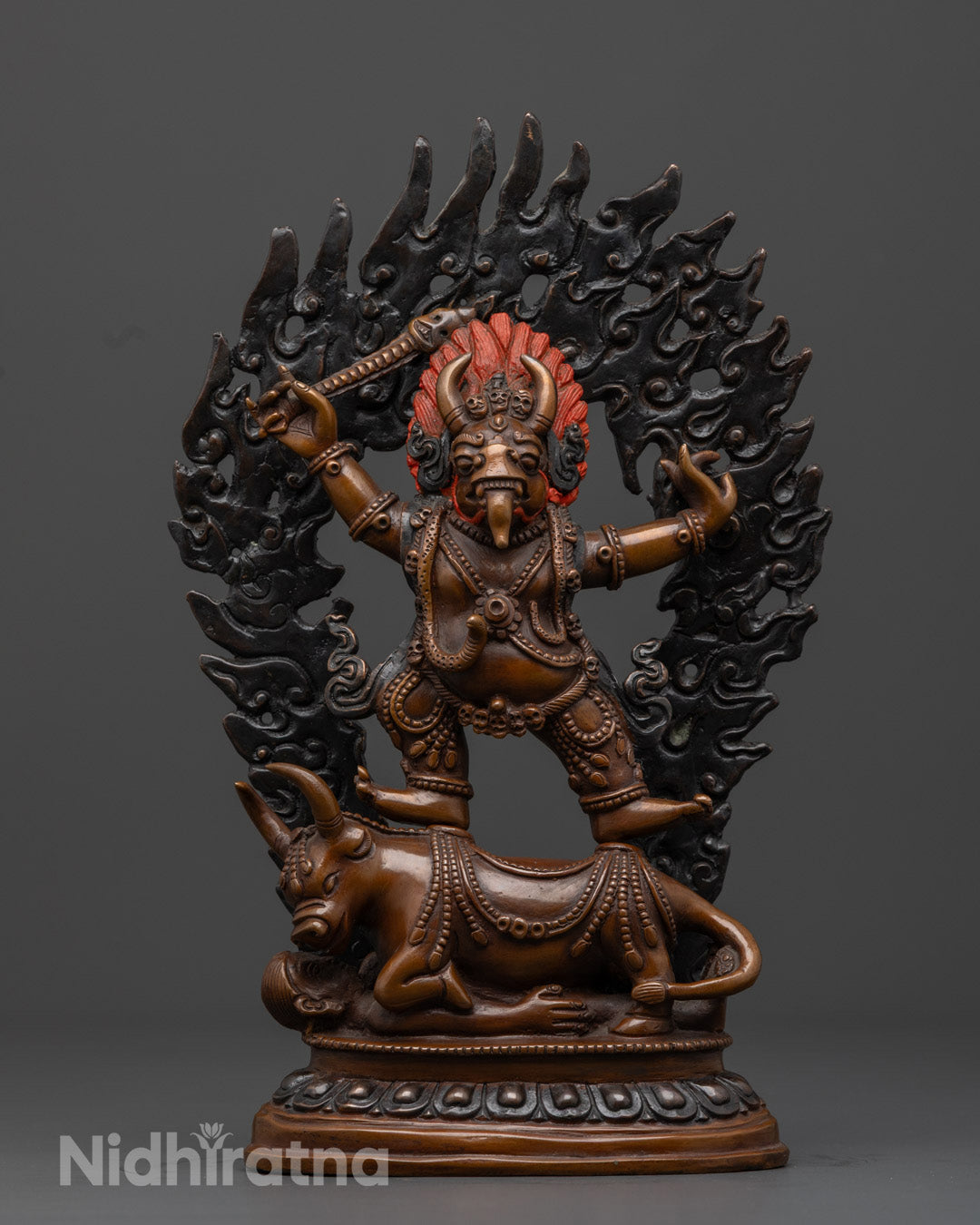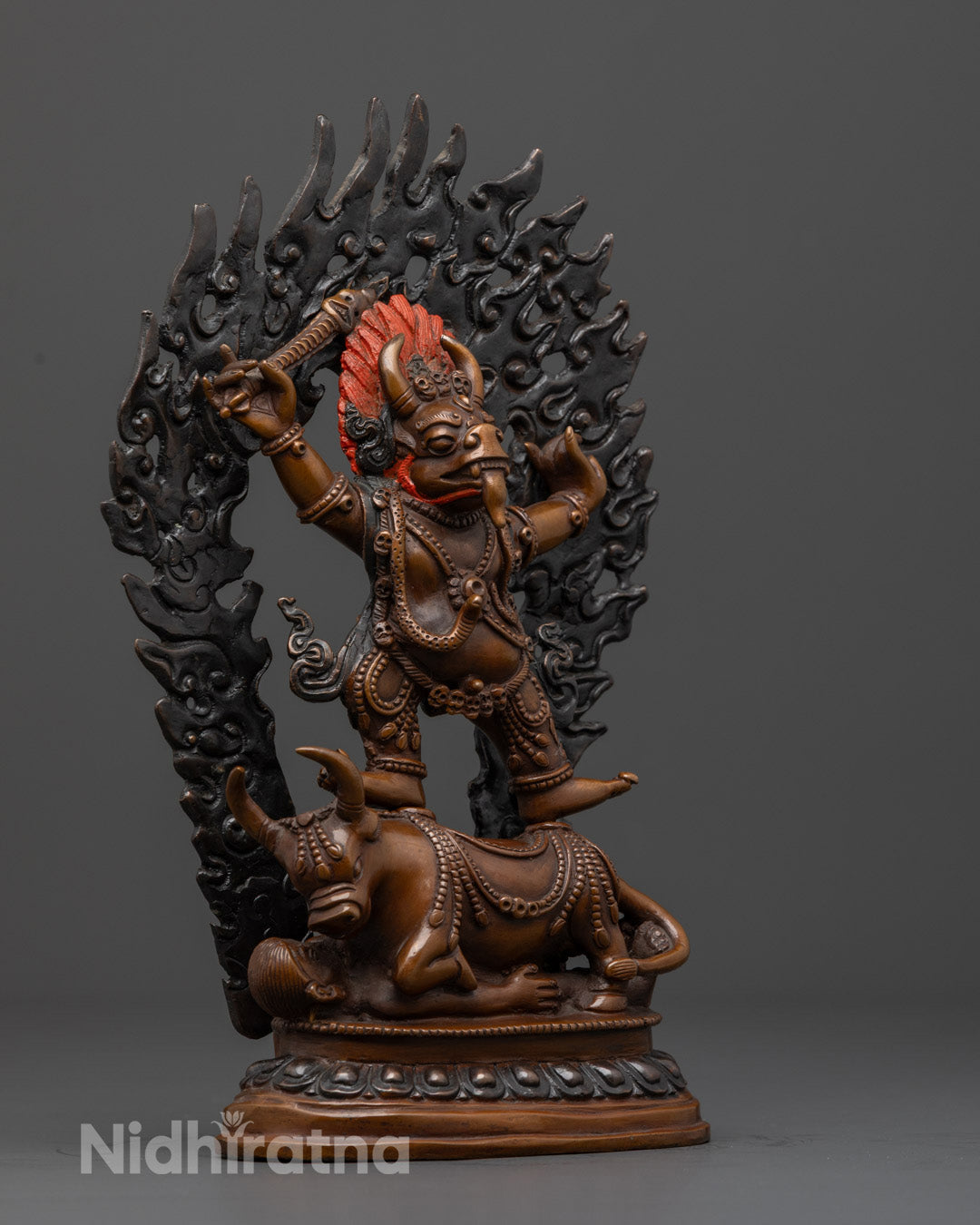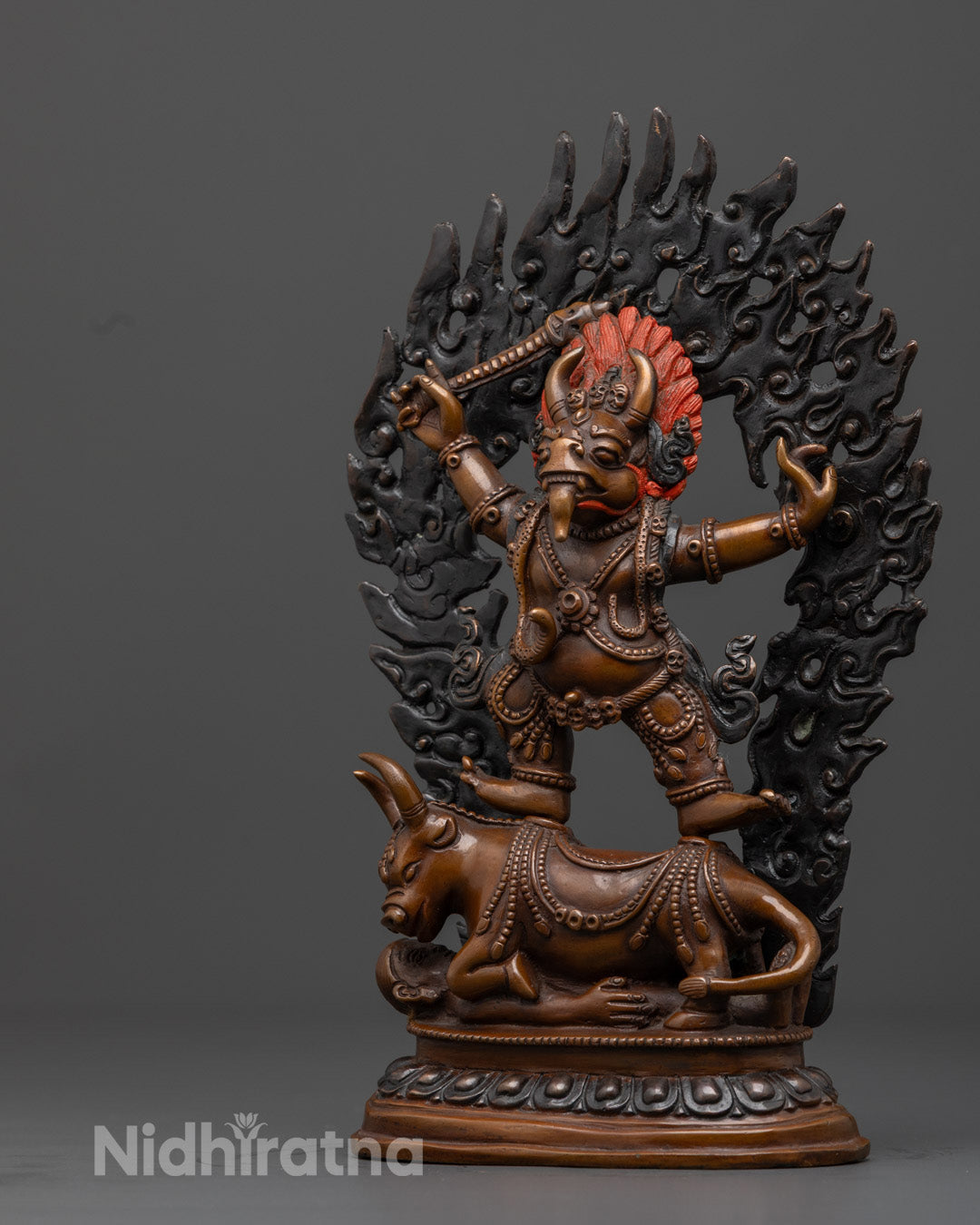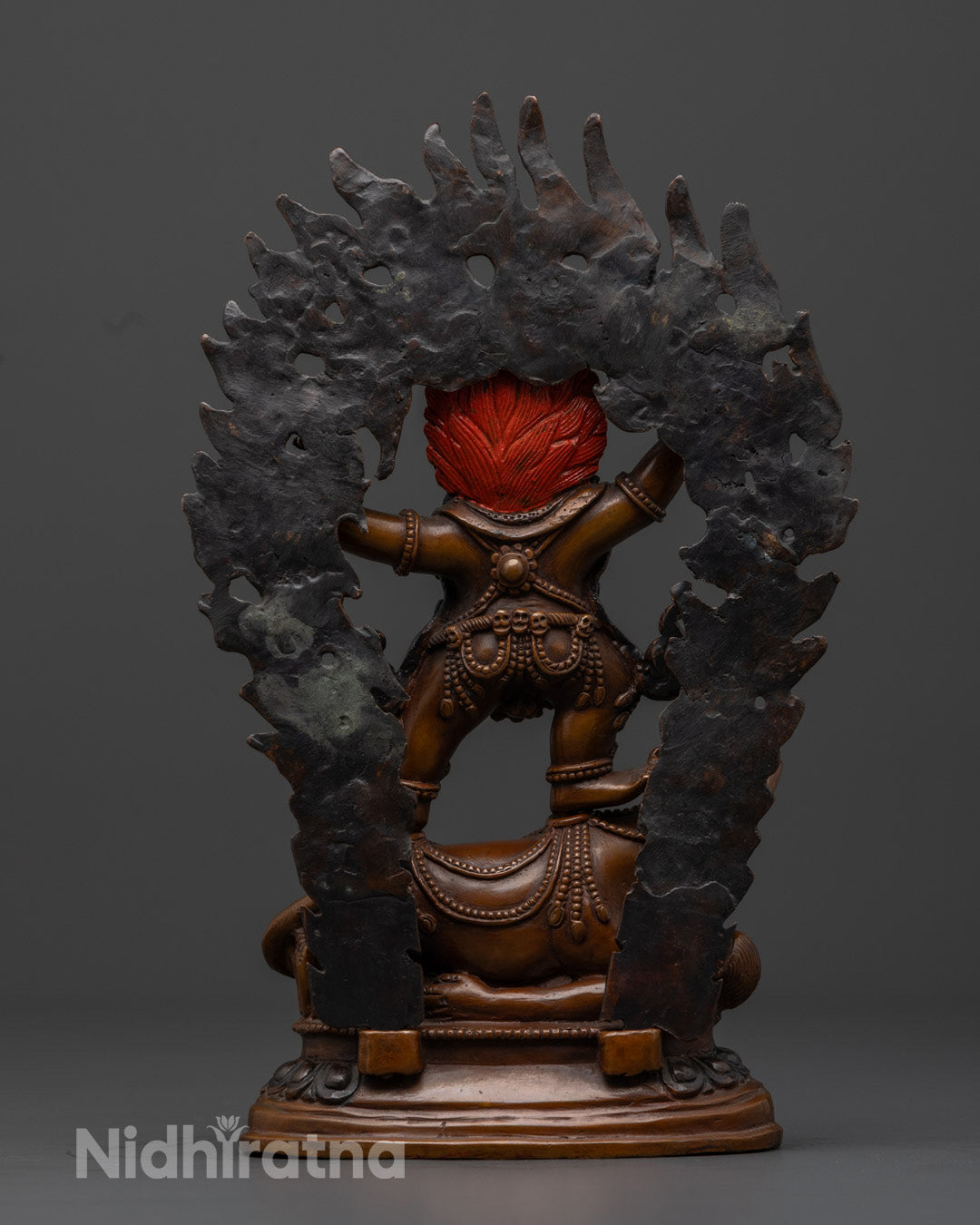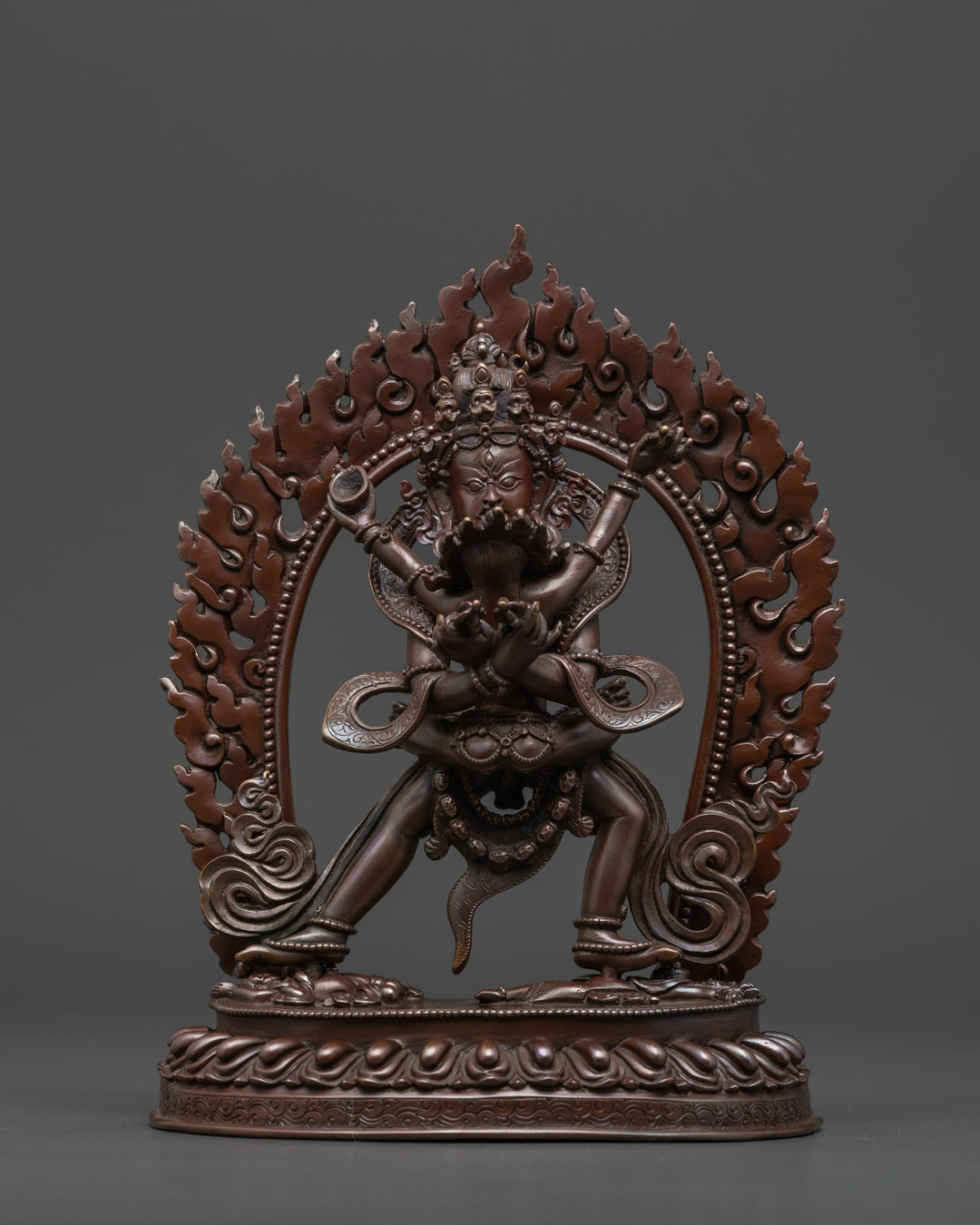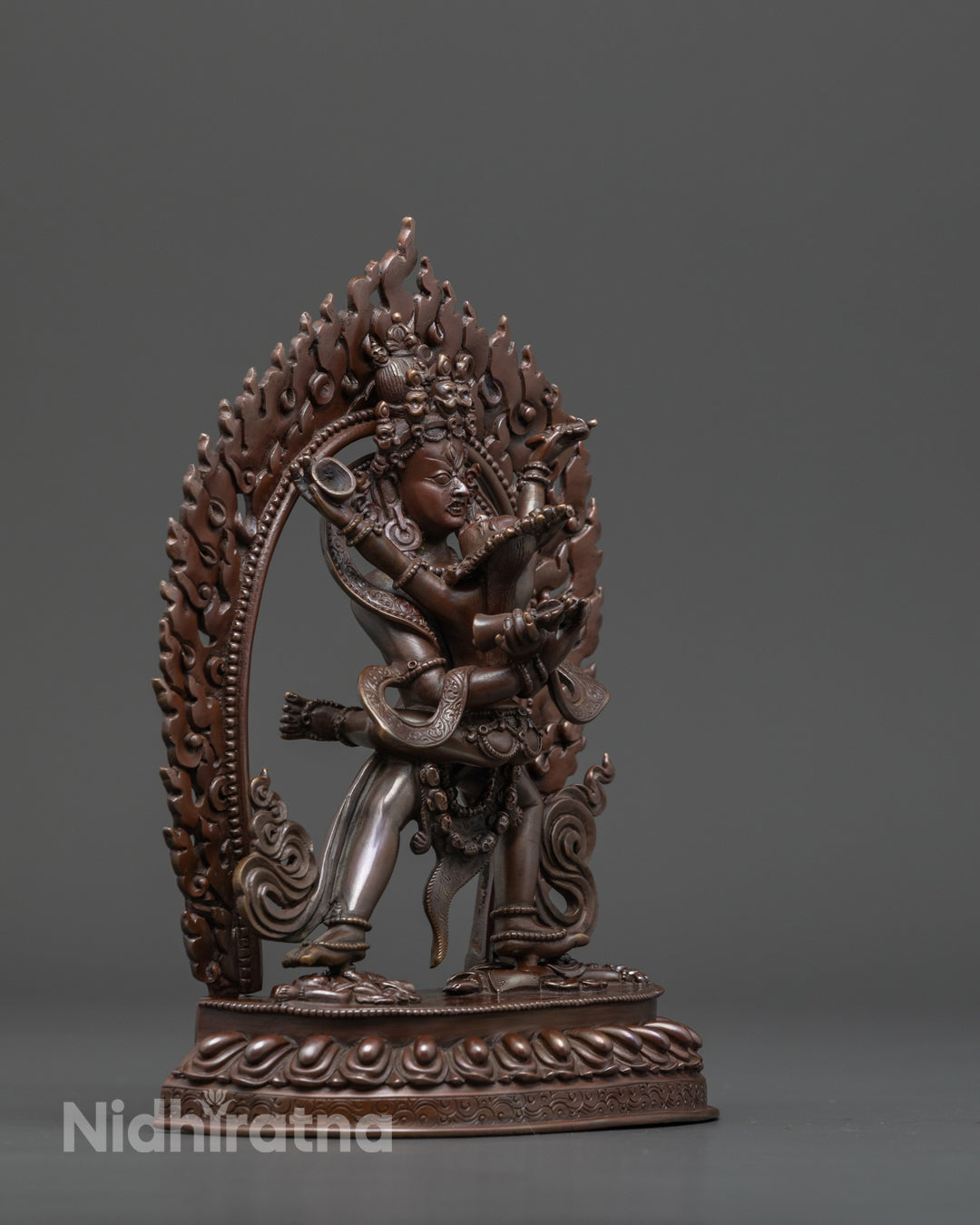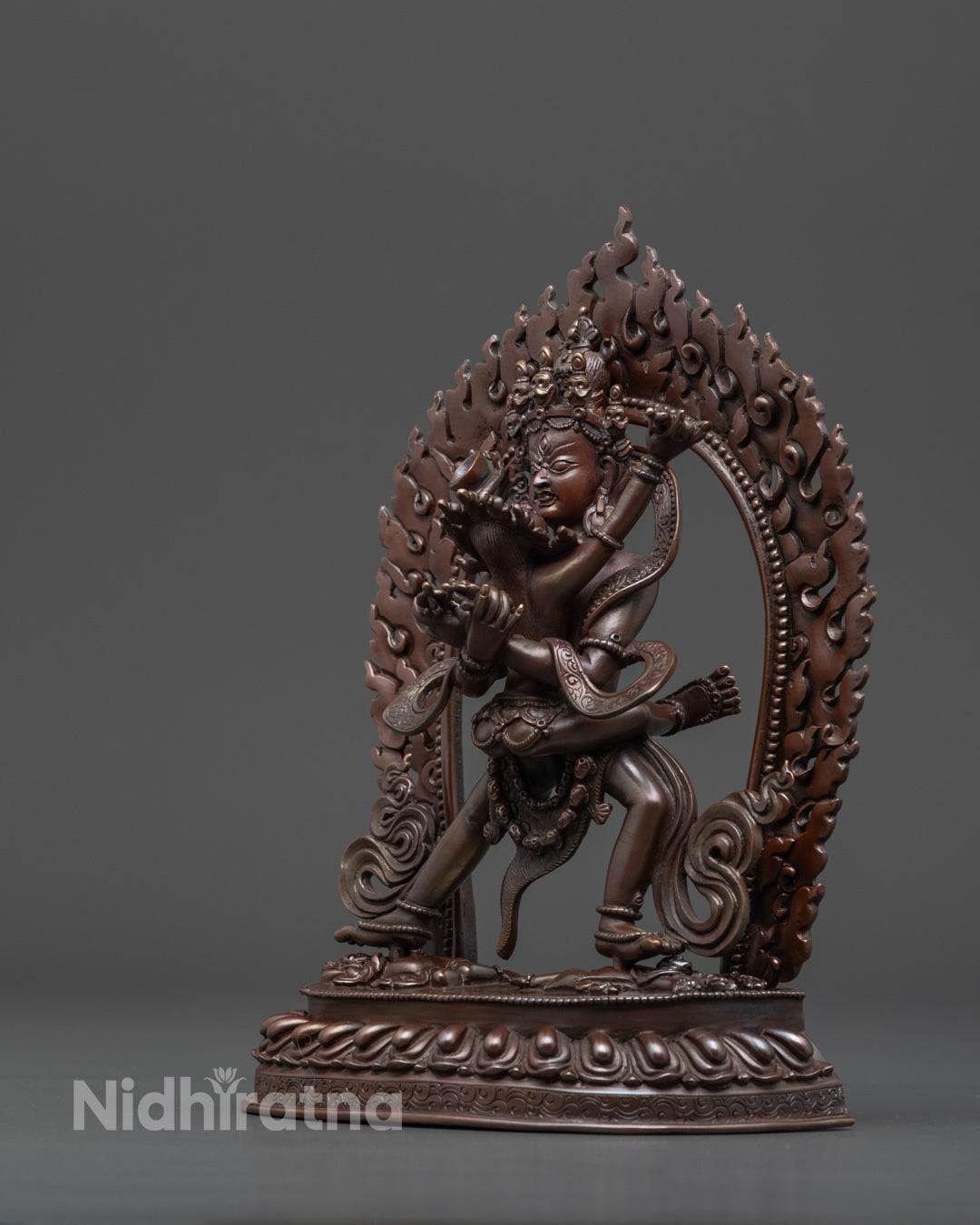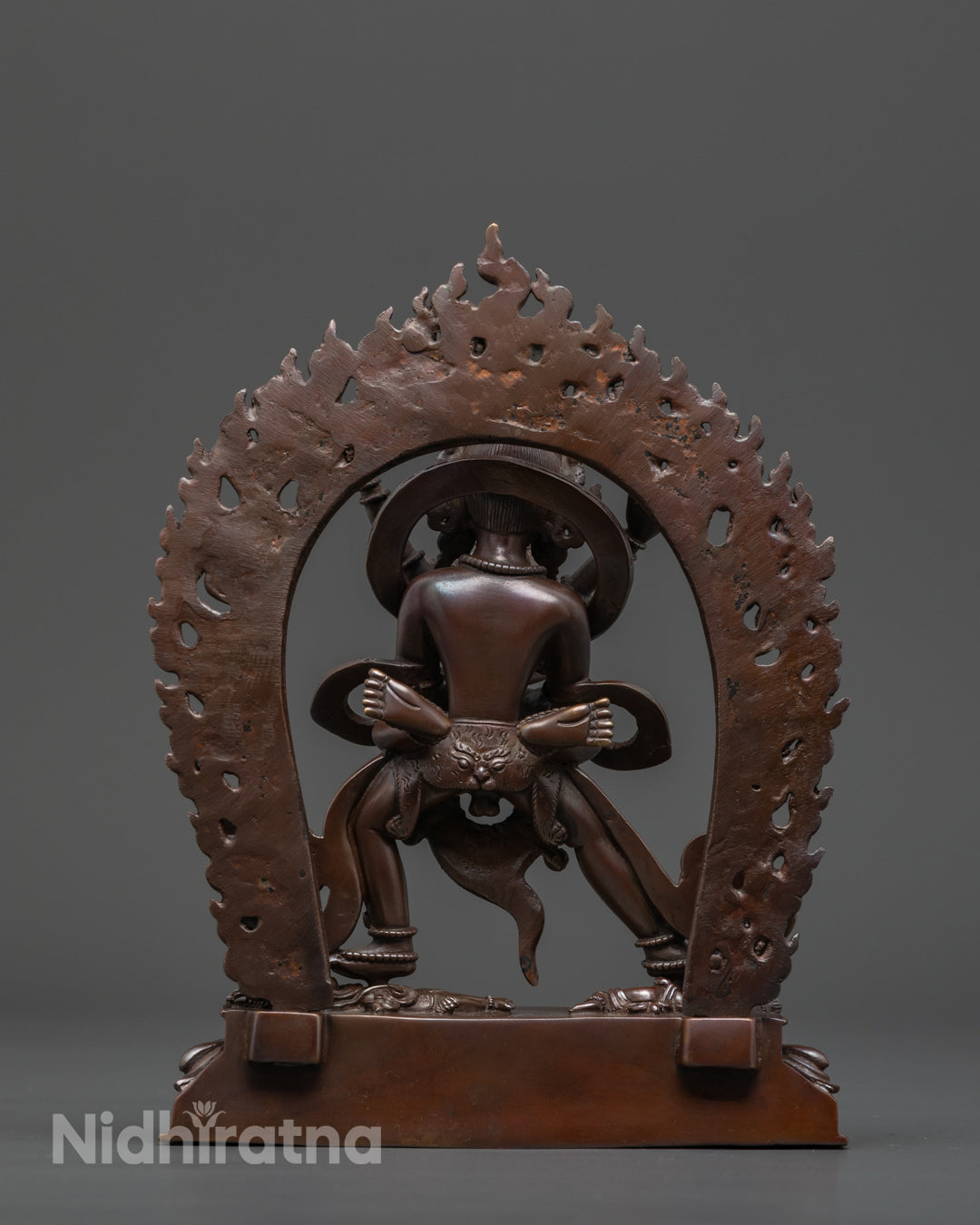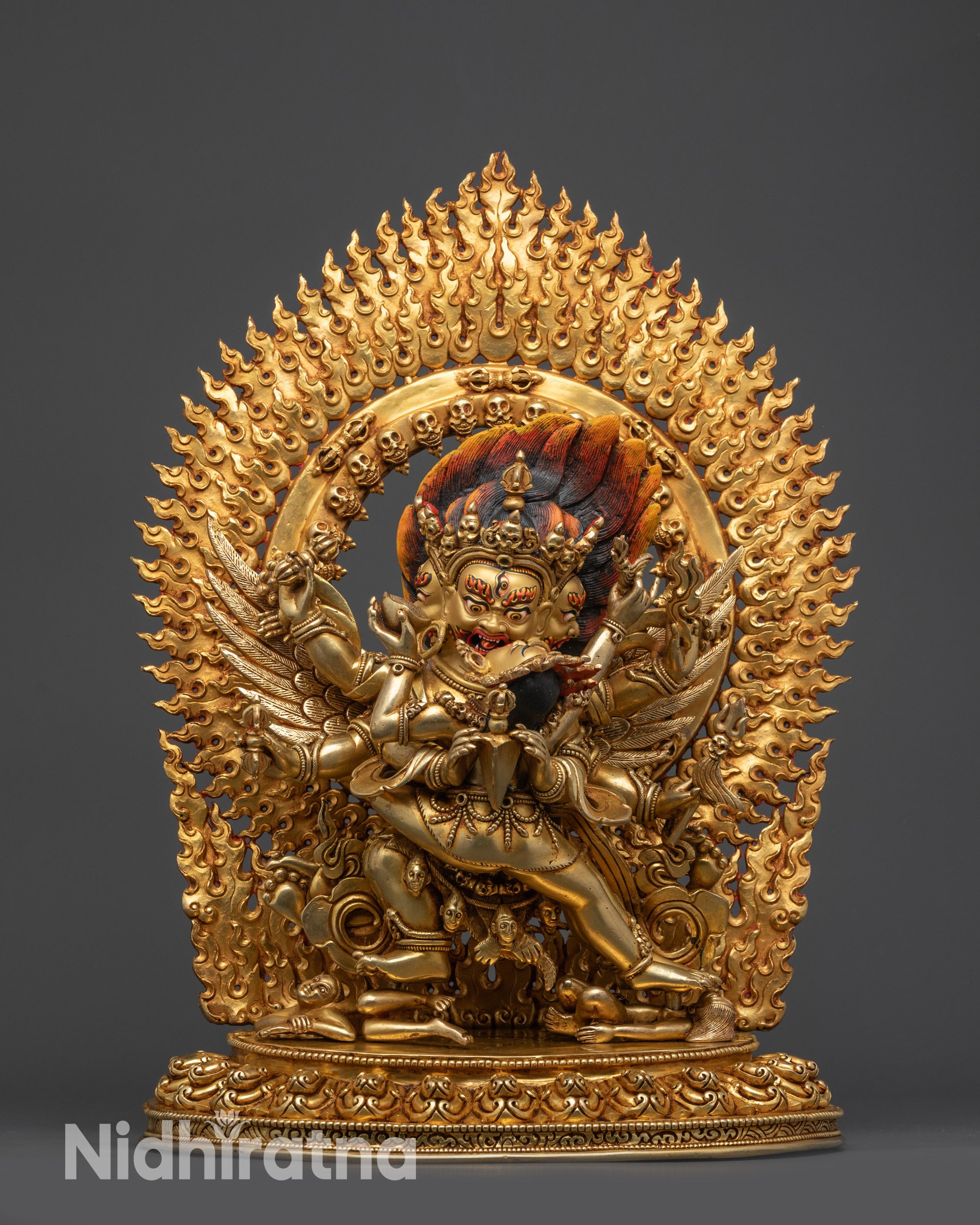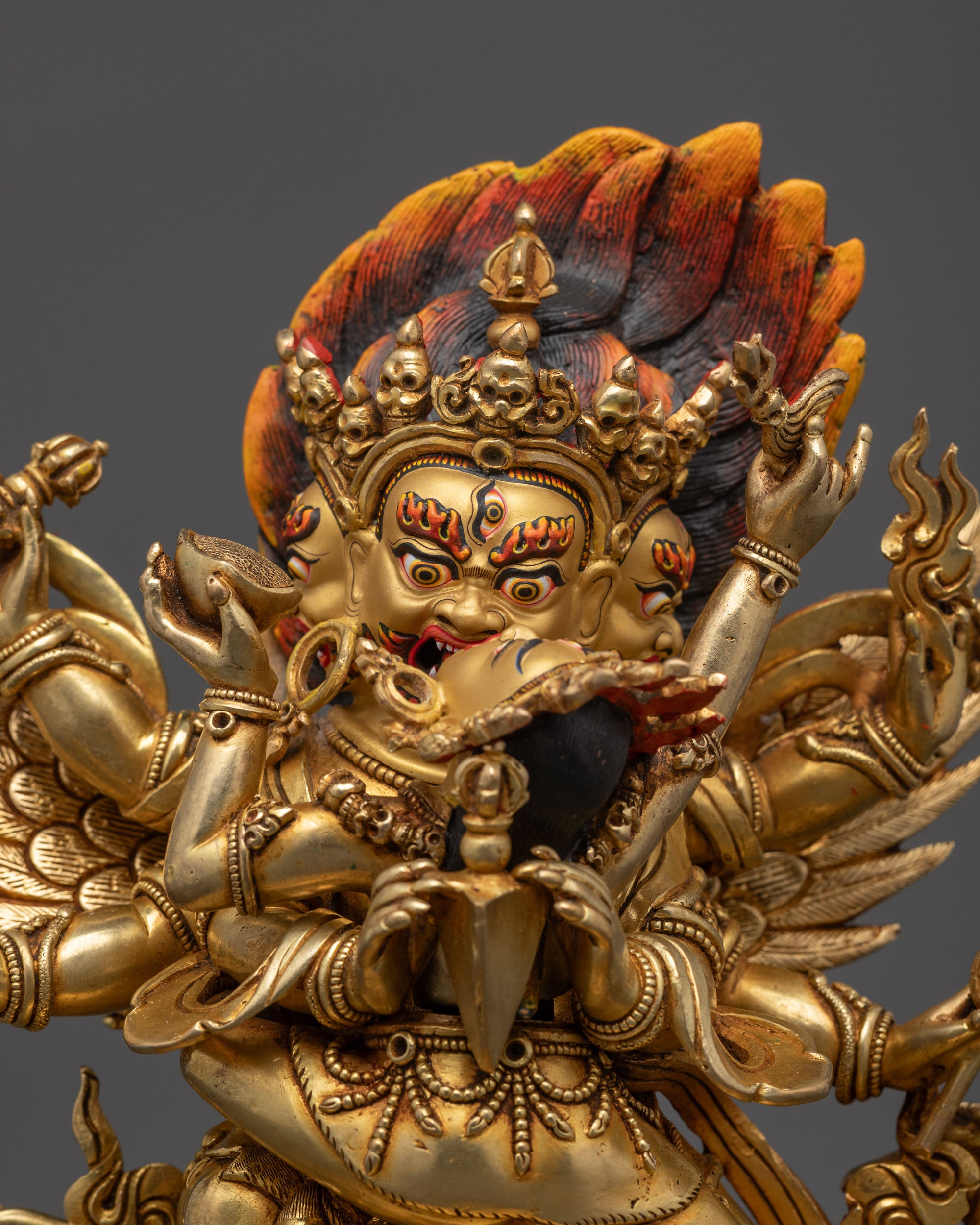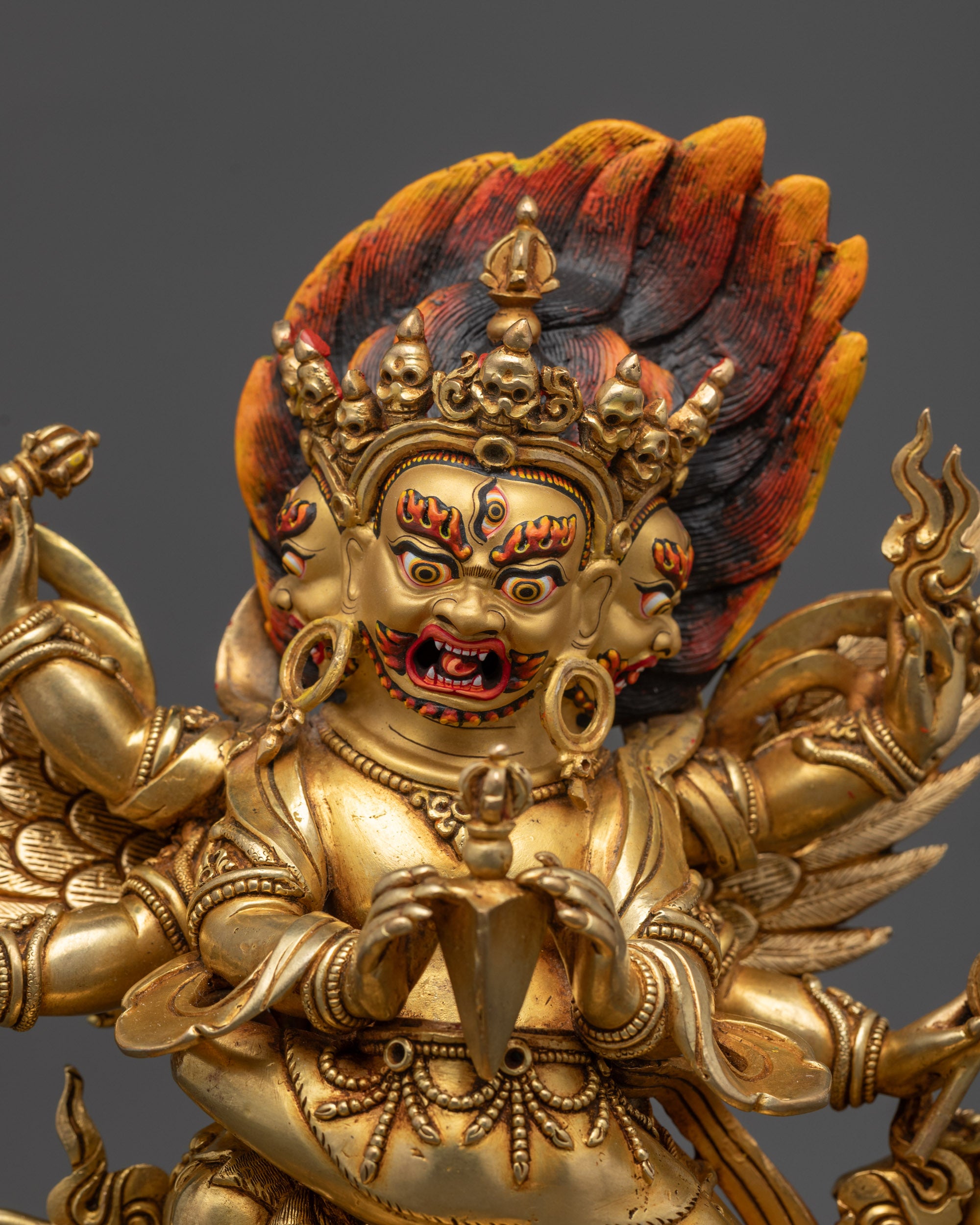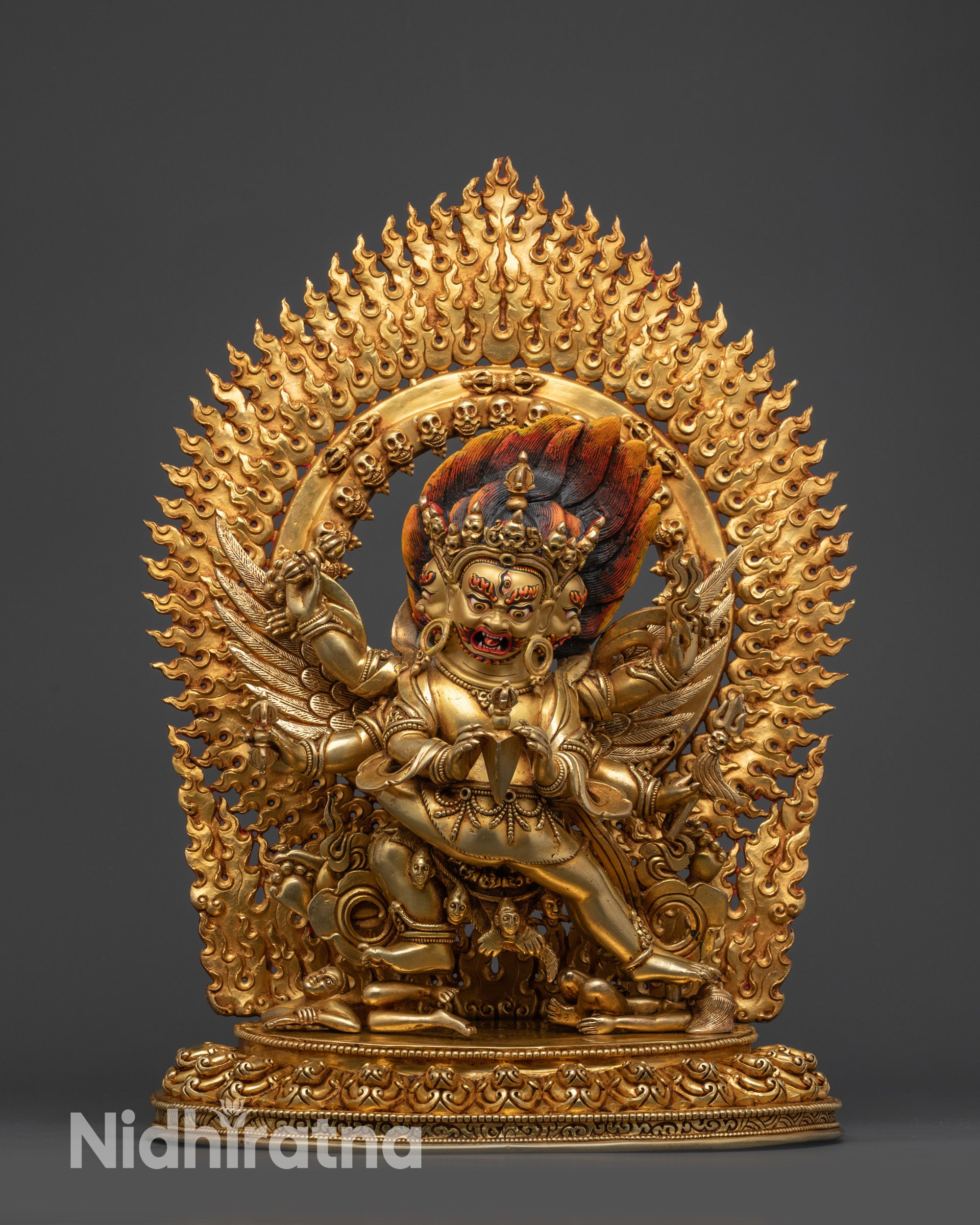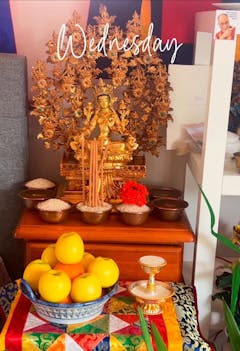Hevajra Statue with Yab Yum Statue | Handcrafted Tantric Buddhist Idol
Chakrasamvara Statue | Traditional Buddhist Tantric Deity Sculpture
Oxidized Vajrabhairava Yamantaka Statue | Handcrafted Buddhist Art
Vajrakilaya Consort Statue | Timeless Religious Art for Altar Spaces
Yamantaka Statue | Tibetan Wrathful Deity of Protection
Lord Yamraj Statue for Meditation and Ritual
Handmade Oxidized Statue of Yamantaka
Handcrafted Vajrakilaya Statue | Buddhist Idol for Home & Altar
Nidhiratna's Yidam Statue: The Divine Meditation Deity of Transformation
Nidhiratna's Yidam statue represents one of the most profound and revered forms in Vajrayana Buddhism—the meditational deity that serves as a bridge between the practitioner and the ultimate wisdom. The Yidam is a divine visualization deity, used in meditation practices to transform the mind and lead the practitioner toward enlightenment. The Yidam is seen as the embodiment of the Buddha’s qualities, and meditating upon it allows practitioners to take on the deity’s attributes and embody their wisdom, compassion, and enlightened state.
Crafted with gold-gilded copper and marked by meticulous artistic mastery, Nidhiratna’s Yidam statue captures the essence of this meditative deity. Every line, gesture, and ornament reflects a deep understanding of the deity’s iconography and symbolism, designed to inspire both practitioners and admirers alike. The artist’s dedication is evident in the fine details of the statue’s pose, expression, and sacred accessories, which all serve as a guide for spiritual practitioners seeking to cultivate higher states of consciousness and wisdom.
Chakrasamvara Statue
Chakrasamvara Statue is a beautiful piece of Tibetan art that represents a powerful deity in Buddhist traditions. This statue often shows Chakrasamvara in a special pose holding symbols like a vajra and a bell which are important in meditation and rituals. Many people use mantras or sacred chants while praying to this statue to bring peace and wisdom. The intricate details and spiritual meaning make the Chakrasamvara Statue a cherished item for those who practice Tibetan Buddhism.
Hayagriva Statue
Hayagriva statue is a sacred and artistic symbol in Tibetan Buddhism depicting the fierce deity Hayagriva who is believed to ward off negativity and bring wisdom. This statue is often crafted with intricate details and features a horse’s head representing power and swift action. Devotees use specific mantras while praying to the statue seeking protection and spiritual growth. As a masterpiece of Tibetan art, the Hayagriva statue combines deep religious meaning with stunning craftsmanship making it a cherished object in Buddhist traditions.
Hevajra Statue
Hevajra statue is a powerful symbol in Tibetan art representing wisdom and strength. Hevajra is a fierce yet compassionate deity who is often depicted with multiple arms, holding sacred objects that signify his spiritual energy. This handcrafted statue is used in Buddhist rituals where monks chant the Hevajra mantra for protection and enlightenment. Made with intricate details from oxidized copper or gold-plated bronze this Buddhist sculpture is perfect for meditation spaces and spiritual collections bringing a deep sense of peace and divine energy to any sacred place.
Yamantaka Statue
A Yamantaka statue is a powerful piece of Tibetan art representing the fierce deity known as the "Conqueror of Death." In Tibetan Buddhism, Yamantaka is the wrathful form of Manjushri the Bodhisattva of Wisdom who assumes this form to vanquish Yama the god of death. Devotees often recite Yamantaka's mantra during meditation seeking protection and transformation on their spiritual journey. These intricately crafted Yamantaka statues adorned with symbolic elements serve as profound reminders of the path to enlightenment and the overcoming of obstacles.
Dorje Drolo Statue
Dorje Drolo is a fierce form of Guru Rinpoche is also known as Padmasambhava in Tibetan Buddhism. Statues of Dorje Drolo depict him in a powerful, wrathful pose often standing or dancing atop a tigress symbolizng his role in taming negative forces. These hand-carved sculptures are significant pieces of Tibetan art embodying both protective and transformative energies. Practitioners often recite specific mantras associated with Dorje Drolo to invoke his blessings and protection.
Vajrakilaya Statue
Vajrakilaya statue is a significant piece of Tibetan art representing a powerful deity known for removing obstacles and negative energies. In Tibetan Buddhism, practitioners recite the Vajrakilaya mantra to invoke these protective qualities. Having such a statue in your space serves as a reminder of inner strength and the transformative power of compassion.
Kalachakra Statue
Kalachakra statue is a significant piece in Tibetan art embodying profound spiritual teachings. The term "Kalachakra" means "Wheel of Time" in Sanskrit represents the cycles of time and the universe. This statue often features intricate designs and symbols including the powerful Kalachakra mantra: "Om Ham Ksha Ma La Va Ra Ya Sva Ha." Displaying the Kalachakra statue in your space not only enhances its aesthetic appeal but also serves as a reminder of the path to enlightenment and inner peace.
Guhyasamaja statue
Guhyasamaja statue is a significant piece in Tibetan art representing the "Secret Assembly" deity from Buddhist teachings. This intricate sculpture often depicts the deity with three heads and six arms symbolizing the union of wisdom and compassion. In Tibetan Buddhism, practitioners recite the Guhyasamaja mantra during meditation to connect with this profound energy. Owning the Guhyasamaja statue not only enhances spiritual practice but also brings the rich heritage of Tibetan craftsmanship into your space.
The Role of Yidam in Vajrayana Buddhism:
The Yidam is a deity to be visualized in meditation offering the practitioner a form to identify with on the path to self-realization. In Vajrayana Buddhism, meditative deities are not seen as separate from the practitioner but as a reflection of their inherent enlightened nature. The Yidam’s form serves as a mirror to the practitioner’s innermost qualities encouraging them to engage with the deity’s wisdom and compassion as they progress on the path toward Buddhahood.
The Yidam may take various forms depending on the practitioner’s specific spiritual goals, practices, and preferences. It may be a peaceful or wrathful deity, a bodhisattva, or an enlightened being, and it is often invoked in Tantric rituals to transform negative energies and purify the mind. Regardless of the form, the Yidam is seen as a guide and a spiritual ally that offers the practitioner insight into the nature of reality and the ability to manifest spiritual wisdom.
Yidam's Iconography and Symbolism :
Each Yidam form carries unique symbolism with a variety of gestures (mudras), attributes, and features that point toward specific teachings and spiritual qualities. Some of the key aspects of a Yidam statue include:
Mudras: The hand gestures of the Yidam are symbolic of their spiritual power. For example, the mudra of teaching (with one hand raised, palm open) signifies the sharing of wisdom while the mudra of fearlessness (with the right hand raised, fingers pointing upward) represents protection from negative forces.
Attributes: Yidams are often depicted holding sacred objects that symbolize key aspects of the Buddha’s teachings. For example, a vajra (diamond scepter) represents indestructible wisdom while a lotus flower symbolizes purity and spiritual awakening. A rosary or dharma wheel often appears to represent continuous practice and the cycle of teachings.
Posture: The posture of the Yidam is whether sitting in a meditative pose or standing in active engagement indicating the deity’s role in guiding practitioners. The seated posture often represents inner peace and meditative focus while the standing posture indicates the Yidam’s active role in protecting and transforming beings.
Appearance: The physical form of the Yidam is whether peaceful or wrathful which is designed to reflect the deity’s essence and the practitioner’s spiritual goals. Peaceful deities generally exhibit serene expressions while wrathful deities are characterized by fierce expressions, meant to overcome obstacles, demons, and ignorance.
Deity’s Energy: Each Yidam is associated with a particular energy or element such as fire, water, earth, or wind and this energy reflects the spiritual qualities that the deity embodies. For example, Vajrayogini is a popular Yidam representing transformation and the power of wisdom, while Chenrezig embodies compassion and unconditional love.
The Importance of Yidam Practice:
The practice of meditating on a Yidam is designed to help the practitioner transform their mind. The Yidam is not an external deity, but a representation of the highest potential within the practitioner. Through the visualization of the deity’s qualities, practitioners can cultivate those same qualities within themselves, ultimately realizing that they too can embody the enlightened state.
The practice involves invoking the Yidam’s name and mantras visualizing their form and meditating upon their qualities to purify negative karma and cultivate positive mental states. As the practitioner progresses the Yidam becomes a powerful spiritual ally, offering guidance, protection, and the wisdom needed to overcome challenges on the spiritual path.
In many cases, Tantric teachings emphasize the importance of deity yoga which is the practice of identifying with the Yidam and ultimately experiencing oneself as the deity. This identification with the Yidam helps the practitioner to access the deity’s wisdom and compassion, transcending the dualistic perception of self and other
.
Yidam’s Mantra:
Each Yidam is associated with a mantra - a sacred phrase or series of syllables that encapsulate the deity’s essence and power. The mantra is often recited as part of the meditation practice, with each repetition helping to purify the mind and draw the practitioner closer to the wisdom of the deity.
For example, the mantra of Vajrayogini a popular Yidam is:
"Om Vajrayogini Hum Phat"
This mantra is used to invoke the deity’s energy purify the mind and enhance the practitioner’s ability to transform their mind and body into the enlightened state of the deity.
Nidhiratna’s Yidam statue is not just an artistic creation but it is a spiritual guide carefully crafted to inspire transformation in those who engage with it. The statue embodies the essence of Yidam’s wisdom, compassion and power and serves as a reminder to practitioners that they too can achieve the enlightened qualities of the deity through dedicated practice. By meditating on the Yidam, practitioners can cultivate mental clarity, wisdom, and compassion, and ultimately, reach Buddhahood. The Yidam represents the spiritual potential within each practitioner, and through visualization and mantra recitation, they are led on the path of transformation and liberation.fted to inspire transformation in those who engage with it.

